10 Example-Hooks for the Introduction to Climate Change College Essay
An essay is only as strong as its hook. If you can’t grab your reader’s attention right within the first few sentences, you won’t have it throughout the rest of the essay, either. Don’t bore your reader! Instead, use a captivating hook to ensnare them from the first few words.

A hook can be something that is intriguing, hilarious, or even shocking. The goal of a hook is to create a powerful emotional connection with the reader. As the writer, you have a few options. You might consider beginning with a series of questions, a challenging statement, a little-known fact, a quotation, or some fascinating background information. For an essay containing an introduction to climate change, consider a few of the following hooks.

Start with a Quote
Find out a famous person who has touched the discussed issue. Make your audience mull over his/her words as well as provide their own thoughts.
- Start with a quote : “Climate change is happening, humans are causing it, and I think this is perhaps the most serious environmental issue facing us.”-Bill Nye
- Start with a quote : “Humanity faces many threats, but none is greater than climate change. In damaging our climate, we are becoming the architects of our own destruction. We have the knowledge, the tools, and the money (to solve the crisis).”-Prince Charles, U.K.
- Start with a quote : “Global warming isn’t a prediction. It is happening.”- James Hansen
Start with a Fact
Provide some interesting information about the particular issue you disclose. This will make your listeners and readers involved in the problem. Make sure the fact is on point and fresh that no one knows about.
- Start with a fact : “The planet’s average surface temperature has risen by two degrees Fahrenheit since the 1900s. This change is unrivaled by any others in recorded–or estimated–history.”
- Start with a fact : “2016 was the warmest year on record, with eight months setting record temperature highs around the globe.”
Start with a Question
Make your audience discuss the issue. This will help you not only make them interested in the problem but also present their own thoughts that might be also quite catchy to discuss.
- Start with a question : “What have you done lately to help prevent global warming?”
- Start with a question : “Think about how the weather has changed since you were a child. Has the weather gradually turned warmer? Colder? Perhaps you notice more snowfall or hotter summer temperatures. These are all caused directly by climate change and global warming.”
- Start with a question : “How does climate change affect you personally?”
Shock Your Audience
Tell something that will shock your audience. It will make them interested. But again, this has to be a real shock, not something that everyone is talking about for the last three years.
- Start with a shock : “Global sea levels have risen eight inches over the last century. In the last two decades alone, the rate of rise has nearly doubled. This is a direct cause of melting ice caps and increased global temperatures. If this rise continues, entire countries, such as Bangladesh, could be underwater.”
- Start with a shock : “If everyone in the world lives as Americans do, it would take five Earths to produce enough resources. Just five countries, including the United States, contribute to more than 50 percent of the world’s harmful CO2 emissions.”
What do all of these hooks have in common? They tell you just enough information to get you interested but want to learn more at the same time. It is often difficult to write a stellar hook until you have already–or nearly–finished writing your essay. After all, you often don’t know the direction your paper is going to take until it is completed. Many strong writers wait to write the hook last, as this helps guide the direction of the introduction. Consider drafting a few sample hooks and then choose the best. The best essay will be the one that involves revision and updating–keep trying new hooks until you find the perfect, most intriguing, hook of them all.
Our statistics
Argumentative Essay Writing
Argumentative Essay About Climate Change

Make Your Case: A Guide to Writing an Argumentative Essay on Climate Change
Published on: Mar 2, 2023
Last updated on: Jan 31, 2024
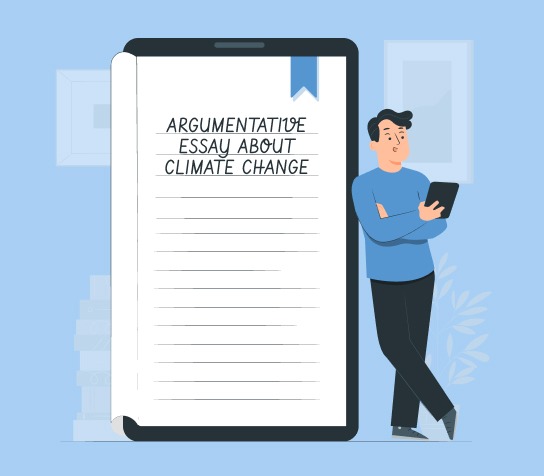
People also read
Argumentative Essay - A Complete Writing Guide
Learn How to Write an Argumentative Essay Outline
Best Argumentative Essay Examples for Your Help
Basic Types of Argument and How to Use Them?
Take Your Pick – 200+ Argumentative Essay Topics
Essential Tips and Examples for Writing an Engaging Argumentative Essay about Abortion
Crafting a Winning Argumentative Essay on Social Media
Craft a Winning Argumentative Essay about Mental Health
Strategies for Writing a Winning Argumentative Essay about Technology
Crafting an Unbeatable Argumentative Essay About Gun Control
Win the Debate - Writing An Effective Argumentative Essay About Sports
Ready, Set, Argue: Craft a Convincing Argumentative Essay About Wearing Mask
Crafting a Powerful Argumentative Essay about Global Warming: A Step-by-Step Guide
Share this article
With the issue of climate change making headlines, it’s no surprise that this has become one of the most debated topics in recent years.
But what does it really take to craft an effective argumentative essay about climate change?
Writing an argumentative essay requires a student to thoroughly research and articulate their own opinion on a specific topic.
To write such an essay, you will need to be well-informed regarding global warming. By doing so, your arguments may stand firm backed by both evidence and logic.
In this blog, we will discuss some tips for crafting a factually reliable argumentative essay about climate change!
On This Page On This Page -->
What is an Argumentative Essay about Climate Change?
The main focus will be on trying to prove that global warming is caused by human activities. Your goal should be to convince your readers that human activity is causing climate change.
To achieve this, you will need to use a variety of research methods to collect data on the topic. You need to make an argument as to why climate change needs to be taken more seriously.
Argumentative Essay Outline about Climate Change
An argumentative essay about climate change requires a student to take an opinionated stance on the subject.
The outline of your paper should include the following sections:
Argumentative Essay About Climate Change Introduction
The first step is to introduce the topic and provide an overview of the main points you will cover in the essay.
This should include a brief description of what climate change is. Furthermore, it should include current research on how humans are contributing to global warming.
An example is:

Paper Due? Why Suffer? That's our Job!
Thesis Statement For Climate Change Argumentative Essay
The thesis statement should be a clear and concise description of your opinion on the topic. It should be established early in the essay and reiterated throughout.
For example, an argumentative essay about climate change could have a thesis statement such as:
Climate Change Argumentative Essay Conclusion
The conclusion should restate your thesis statement and summarize the main points of the essay.
It should also provide a call to action, encouraging readers to take steps toward addressing climate change.
For example,
How To Write An Argumentative Essay On Climate Change
Writing an argumentative essay about climate change requires a student to take an opinionated stance on the subject.
Following are the steps to follow for writing an argumentative essay about climate change
Do Your Research
The first step is researching the topic and collecting evidence to back up your argument.
You should look at scientific research, articles, and data on climate change as well as current policy solutions.
Pick A Catchy Title
Once you have gathered your evidence, it is time to pick a title for your essay. It should be specific and concise.
Outline Your Essay
After selecting a title, create an outline of the main points you will include in the essay.
This should include an introduction, body paragraphs that provide evidence for your argument, and a conclusion.
Compose Your Essay
Finally, begin writing your essay. Start with an introduction that provides a brief overview of the main points you will cover and includes your thesis statement.
Then move on to the body paragraphs, providing evidence to back up your argument.
Finally, conclude the essay by restating your thesis statement and summarizing the main points.
Proofread and Revise
Once you have finished writing the essay, it is important to proofread and revise your work.
Check for any spelling or grammatical errors, and make sure the argument is clear and logical.
Finally, consider having someone else read over the essay for a fresh perspective.
By following these steps, you can create an effective argumentative essay on climate change. Good luck!
Examples Of Argumentative Essays About Climate Change
Climate Change is real and happening right now. It is one of the most urgent environmental issues that we face today.
Argumentative essays about this topic can help raise awareness that we need to protect our planet.
Below you will find some examples of argumentative essays on climate change written by CollegeEssay.orgâs expert essay writers.
Argumentative Essay About Climate Change And Global Warming
Persuasive Essay About Climate Change
Argumentative Essay About Climate Change In The Philippines
Argumentative Essay About Climate Change Caused By Humans
Geography Argumentative Essay About Climate Change
Check our extensive blog on argumentative essay examples to ace your next essay!
Good Argumentative Essay Topics About Climate Change
Choosing a great topic is essential to help your readers understand and engage with the issue.
Here are some suggestions:
- Should governments fund projects that will reduce the effects of climate change?
- Is it too late to stop global warming and climate change?
- Are international treaties effective in reducing carbon dioxide emissions?
- What are the economic implications of climate change?
- Should renewable energy be mandated as a priority over traditional fossil fuels?
- How can individuals help reduce their carbon footprint and fight climate change?
- Are regulations on industry enough to reduce global warming and climate change?
- Could geoengineering be used to mitigate climate change?
- What are the social and political effects of global warming and climate change?
- Should companies be held accountable for their contribution to climate change?
Check our comprehensive blog on argumentative essay topics to get more topic ideas!
We hope these topics and resources help you write a great argumentative essay about climate change.
Now that you know how to write an argumentative essay about climate change, itâs time to put your skills to the test.
Overwhelmed with assignments and thinking, "I wish someone could write me an essay "?
Our specialized writing service is here to turn that wish into reality. With a focus on quality, originality, and timely delivery, our team of professionals is committed to crafting essays that align perfectly with your academic goals.
And for those seeking an extra edge, our essay writer , an advanced AI tool, is ready to elevate your writing to new heights.
Frequently Asked Questions
What is a good introduction to climate change.
An introduction to a climate change essay can include a short description of why the topic is important and/or relevant.
It can also provide an overview of what will be discussed in the body of the essay.
The introduction should conclude with a clear, focused thesis statement that outlines the main argument in your essay.
What is a good thesis statement for climate change?
A good thesis statement for a climate change essay should state the main point or argument you will make in your essay.
You could argue that “The science behind climate change is irrefutable and must be addressed by governments, businesses, and individuals.”
Cathy A. (Medical school essay, Education)
For more than five years now, Cathy has been one of our most hardworking authors on the platform. With a Masters degree in mass communication, she knows the ins and outs of professional writing. Clients often leave her glowing reviews for being an amazing writer who takes her work very seriously.
Paper Due? Why Suffer? That’s our Job!

Keep reading

Legal & Policies
- Privacy Policy
- Cookies Policy
- Terms of Use
- Refunds & Cancellations
- Our Writers
- Success Stories
- Our Guarantees
- Affiliate Program
- Referral Program
- AI Essay Writer
Disclaimer: All client orders are completed by our team of highly qualified human writers. The essays and papers provided by us are not to be used for submission but rather as learning models only.
Climate Change Essay for Students and Children
500+ words climate change essay.
Climate change refers to the change in the environmental conditions of the earth. This happens due to many internal and external factors. The climatic change has become a global concern over the last few decades. Besides, these climatic changes affect life on the earth in various ways. These climatic changes are having various impacts on the ecosystem and ecology. Due to these changes, a number of species of plants and animals have gone extinct.

When Did it Start?
The climate started changing a long time ago due to human activities but we came to know about it in the last century. During the last century, we started noticing the climatic change and its effect on human life. We started researching on climate change and came to know that the earth temperature is rising due to a phenomenon called the greenhouse effect. The warming up of earth surface causes many ozone depletion, affect our agriculture , water supply, transportation, and several other problems.
Reason Of Climate Change
Although there are hundreds of reason for the climatic change we are only going to discuss the natural and manmade (human) reasons.
Get the huge list of more than 500 Essay Topics and Ideas
Natural Reasons
These include volcanic eruption , solar radiation, tectonic plate movement, orbital variations. Due to these activities, the geographical condition of an area become quite harmful for life to survive. Also, these activities raise the temperature of the earth to a great extent causing an imbalance in nature.
Human Reasons
Man due to his need and greed has done many activities that not only harm the environment but himself too. Many plant and animal species go extinct due to human activity. Human activities that harm the climate include deforestation, using fossil fuel , industrial waste , a different type of pollution and many more. All these things damage the climate and ecosystem very badly. And many species of animals and birds got extinct or on a verge of extinction due to hunting.
Effects Of Climatic Change
These climatic changes have a negative impact on the environment. The ocean level is rising, glaciers are melting, CO2 in the air is increasing, forest and wildlife are declining, and water life is also getting disturbed due to climatic changes. Apart from that, it is calculated that if this change keeps on going then many species of plants and animals will get extinct. And there will be a heavy loss to the environment.
What will be Future?
If we do not do anything and things continue to go on like right now then a day in future will come when humans will become extinct from the surface of the earth. But instead of neglecting these problems we start acting on then we can save the earth and our future.

Although humans mistake has caused great damage to the climate and ecosystem. But, it is not late to start again and try to undo what we have done until now to damage the environment. And if every human start contributing to the environment then we can be sure of our existence in the future.
{ “@context”: “https://schema.org”, “@type”: “FAQPage”, “mainEntity”: [ { “@type”: “Question”, “name”: “What is climate change and how it affects humans?”, “acceptedAnswer”: { “@type”: “Answer”, “text”: “Climate change is a phenomenon that happens because of human and natural reasons. And it is one of the most serious problems that not only affect the environment but also human beings. It affects human in several ways but in simple language, we can say that it causes many diseases and disasters that destroy life on earth.” } }, { “@type”: “Question”, “name”: “Can we stop these climatic changes?”, “acceptedAnswer”: { “@type”: “Answer”, “text”: “Yes, we can stop these climatic changes but for that, every one of us has to come forward and has to adapt ways that can reduce and control our bad habits that affect the environment. We have to the initiative and make everyone aware of the climatic changes.” } } ] }
Customize your course in 30 seconds
Which class are you in.

- Travelling Essay
- Picnic Essay
- Our Country Essay
- My Parents Essay
- Essay on Favourite Personality
- Essay on Memorable Day of My Life
- Essay on Knowledge is Power
- Essay on Gurpurab
- Essay on My Favourite Season
- Essay on Types of Sports
Leave a Reply Cancel reply
Your email address will not be published. Required fields are marked *
Download the App

- Dissertation
- PowerPoint Presentation
- Book Report/Review
- Research Proposal
- Math Problems
- Proofreading
- Movie Review
- Cover Letter Writing
- Personal Statement
- Nursing Paper
- Argumentative Essay
- Research Paper
- Discussion Board Post
Steps To Follow While Writing An Essay On Climate Change

Table of Contents

Climate change is the most essential issue of our generation; we are the first to witness its early signs and the last who have a chance of stopping them from happening.
Living in a bubble of denial can only get us this far; the planet which is our home is already a scene for melting glaciers, raising floods, extinction of species… the list goes on and on. Spreading awareness on matters of climate change through any means available, including as seemingly trivial form as writing a school essay, cannot be underestimated.
Follow the guidelines suggested in the paragraphs below to learn how to create a perfect essay that will get you an appraisal of your teacher.
Essay on climate changes: how to write?
If you really want to make your teacher gasp while they are reading your work, there are three vital things to pay attention to .
First of all, read the topic carefully and understand it’s specific, i.e., what is expected from you.
For instance, if it is the role of individuals in helping prevent climate change, you should not focus so much on the global problems, but speak about how small changes all of us can introduce in our routines will eventually have a positive environmental effect.
Secondly, determine your personal take on the problem . Search for materials on your subject using keywords, and pile up the evidence that supports your point of view.
Finally, write a conclusion. Make sure that the conclusion you make reflects the viewpoints you have been expressing all throughout your essay.
Below you will find a more detailed breakdown of tasks you will have to accomplish to complete writing an essay on climate changes that is worthy of a top mark.
Check if it is an argumentative essay on climate change or more of a speculative one? Arrange your writing accordingly.
- Craft the outline and don’t go off-topic.
- Search for keywords .
- Make a plan .
- Avoid the most common mistakes from the start.
- Write an introduction thinking about what you will write later.
- Develop your ideas according to the outline .
- Make a conclusion which is consistent with what you’ve written in the main paragraphs.
- Proofread the draft , correct mistakes and print out the hard copy. All set!
One of the most focal of your writing will be factual evidence. When writing on climate change, resort to providing data shared by international organizations like IPCC , WWF , or World Bank .
It is undeniable that among the main causes of climate change, unfortunately, there are oil and fossil fuels that are the basis of the whole economy and still invaluable sources of energy.
Although everyone knows that oil resources are polluting and that it would be much more useful and environmentally sustainable to rely on renewable energies such as wind and solar energies and electricity, the power of the world seem not to notice or pretend not to see for don’t go against your own interests.
The time has come to react and raise awareness of the use of renewable energy sources.
In addition to the causes already mentioned, we must consider the increase in the carbon dioxide air that traps heat in our atmosphere, thus increasing the temperatures with the consequent of the Arctic glaciers melting.
WWF reported that in 2016, the recorded data was quite worrying with a constant increase in temperatures and a 40% decrease in Arctic marine glaciers.
Topics for essay on global warming and climate change
If you do not have any specific topic to write on, consider yourself lucky. You can pick one that you are passionate about – and in fact, this is what you should do! If we think back to the very definition of essay, it is nothing more than a few paragraphs of expressing one’s personal attitude and viewpoints on a certain subject. Surely, you need to pick a subject that you are opinionated about to deliver a readable piece of writing!
Another point to consider is quaintness and topicality factors. You don’t want to end up writing on a subject that the rest of your class will, and in all honesty, that has zero novelty to it.
Even if it is something as trivial as the greenhouse effect, add an unexpected perspective to it: the greenhouse effect from the standpoint of the feline population of Montenegro. Sounds lunatic, but you get the drift.
Do not worry, below you will find the list of legitimately coverable topics to choose from:
- The last generation able to fight the global crisis.
- Climate change: top 10 unexpected causes.
- Climate changes. Things anyone can do.
- Climate changes concern everyone. Is it true?
- The Mauna Loa volcano: climate change is here.
- Water pollution and coastal cities: what needs to be done?
- Is there global warming if it’s still cold?
- The CO2 concentration in the atmosphere.
- Celebrity activists and climate changes.
- Individual responsibility for the environment.
- How the loss of biodiversity is the biggest loss for humanity.
- Ways to fight global warming at home.
- Sustainable living as a way of fighting climate change.
- Climate change fighting countries to look up to.
- Industrial responsibility and climate change.
- What future will be like if we fail to make an environmental stand?
- Discovering water on Mars: a new planet to live on?
- Climate change effects on poor countries.
- Nuclear power laws and climate change.
- Is it true that climate change is caused by man?
Mistakes to avoid when writing an essay on climate change
When composing your essay, you must avoid the following (quite common!) mistakes:
- Clichés – no one wants to read universal truths presented as relevant discoveries.
- Repeating an idea already expressed – don’t waste your readers’ time .
- Making an accumulation of ideas that are not connected and that do not follow one another; structure your ideas logically .
- Being contradictive (check consistency).
- Using bad or tired collocations .
- Using lackluster adjectives like “good”/”bad”. Instead, think of more eye-catching synonyms.
Structure your essay in a logical way : introduce your thesis, develop your ideas in at least 2 parts that contain several paragraphs, and draw a conclusion.
Bottom line
Writing an essay on global warming and climate change is essentially reflecting on the inevitable consequence of the irresponsible behavior of people inhabiting the planet. Outside of big-scale thinking, there is something each of us can do, and by shaping minds the right way, essential change can be done daily.
Each of us can act to protect the environment, reducing the use of plastic, recycling, buying food with as little packaging as possible, or turning off water and light when not in use. Every little help, even a short essay on climate change can help make a difference.
Can’t wait to save the planet? Do it, while we write your essay. Easy order, complete confidentiality, timely delivery. Click the button to learn more!

The best approach to writing a research paper on breast cancer
How to format a college essay.

Pop Culture Essay – Thoughts on Writing

Climate Change Essay: Example and Tips

The following example of climate change essay should be used as a source of information and inspiration. We do not advise direct copy and paste of the parts of the text or the whole paper, because of plagiarism detection. For the ease of use, the paper is divided into logical parts.
- 1.1 Introduction to climate change essay example
- 1.2 Body of climate change essay example
- 1.3.1 Natural disasters
- 1.3.2 Unsuitable territories for living
- 1.3.3 The impact on biological diversity
- 1.3.4 Lack of drinking water, hunger and epidemics
- 1.3.5 Increasing the level of the world ocean
- 1.4.1 Adapting the life of society to new conditions
- 1.4.2 Reducing greenhouse gas emissions
- 1.5 Conclusion to the climate change essay example
Example of climate change essay
Introduction to climate change essay example.
In recent years, the climate on Earth has changed markedly: some countries suffer from anomalous heat, others from too harsh and snowy winters unusual for these places.
Environmentalists talk about global climate change including an increase in the average annual temperature causing melting of glaciers and an increase in the level of the world’s oceans. In addition to warming, there is also an unbalance of all natural systems, which leads to a change in the regime of precipitation, temperature anomalies and an increase in the frequency of extreme events such as hurricanes, floods and droughts.
According to scientists, for ten months of 2015 the average temperature of the planet was 1.02° C higher than that recorded in the XIX century (when the observation of changes in global temperature began). The threshold of one degree was exceeded for the first time in modern history. Scientists agree that the cause lies in human activity – burning of oil, gas and coal – that leads to greenhouse effect that causes an increase in average temperature. Experts note that between 2000 and 2010, the most powerful increase in greenhouse gas emissions over the past 30 years has been observed. According to the World Meteorological Organization, in 2014, their concentration in the atmosphere reached a record high level.
Secretary General of the World Meteorological Organization Michel Jarraud said: “We do not see CO2. This is not a visible threat, but quite real. This means an increase in global temperatures, an increase in the number of extreme weather events, such as floods, melting ice, rising sea level and increasing the acidity of the oceans.”
Body of climate change essay example
If countries do not begin to seriously deal with the problem of environmental protection, by 2100 the temperature on the planet can rise by 3.7-4.8° C. Climatologists warn: irreversible consequences for the ecology will come even with a warming of more than 2° C.
In order to draw maximum attention to climate problems, the UN has attracted not only politicians and scientists, but also celebrities, to the debate. Hollywood actor Robert Redford in his statement warned that for the international community “the time of half measures and the denial of the problem of climate change has ended.”
“We see the effects of this phenomenon (climate change) everywhere – from drought and hunger in Africa and the drying up heat in South Asia to wildfires in North America, devastating hurricanes and floods in New York. We must act together because climate change affects every country” – actor Robert Redford.
What are the consequences for the planet, if the temperature rise can not be stopped?
Natural disasters.
The climatic zones will shift, the weather changes will become more severe (severe frosts, followed by sudden thaws in winter, an increase in the number of abnormally hot days in summer). The frequency and strength of abnormal phenomena such as droughts and floods will increase.
The connection between climate change and the emergence of natural disasters was proved by American scientists who discovered traces of warming in the study of tropical cyclones in the Pacific, unusually high summer temperatures in Europe, China, South Korea and Argentina, and forest fires in the US state of California. Climate change has also catalyzed drought in Africa and the Middle East, snowstorms in Nepal and torrential downpours that have caused floods in Canada and New Zealand.
Unsuitable territories for living
Some countries due to increased humidity and high average temperature by 2100 may become unsuitable for life. According to a study by American scientists, Qatar, Saudi Arabia, Bahrain, the United Arab Emirates and other countries of the Middle East are at risk.
According to the calculations of climatologists, at the current rate of growth of greenhouse gas emissions by 2070 the average air temperature in the countries of the Persian Gulf can reach 74-77° C. This will make the territories unsuitable for people. An exception may be large megacities with a developed air conditioning system. But people will be able to leave the house only at night.
The impact on biological diversity
According to some scientists, we are in the middle of the sixth in the history of the Earth mass extinction of species. And this time this process is caused by human actions. If climate warming does not stop, many ecosystems, species of living beings that they contain, will become less diverse, less saturated.
There are forecasts of extinction of up to 30-40% of plant and animal species, as their habitat will change faster than they can adapt to these changes.
Lack of drinking water, hunger and epidemics
UN experts warn that warming will negatively affect yields, especially in the underdeveloped countries of Africa, Asia and Latin America, which will lead to food problems. According to scientists, by 2080 the number of people facing the threat of hunger can increase by 600 million people.
Another important consequence of climate change may be a shortage of drinking water. In regions with arid climate (Central Asia, the Mediterranean, South Africa, Australia, etc.), the situation will be further exacerbated by the reduction in rainfall.
Hunger, water scarcity, and insect migration can lead to an increase in epidemics and the spread of tropical diseases such as malaria in the northern regions.
Climate change can affect not only people’s health, but also increase the risk of political disagreements and conflicts for access to water and food resources.
Increasing the level of the world ocean
One of the most tangible consequences of climate warming is likely to be the melting of glaciers and an increase in the level of the World Ocean. Millions of people on the coast will die from frequent floods or will be forced to relocate, UN analysts predict.
According to the expert community, sea level rise in the 21st century will be up to 1 m (in the 20th century – 0.1-0.2 m). In this case, the most vulnerable are the lowlands, coastal areas and small islands.
The first to enter the risk zone are the Netherlands, Bangladesh and small island states, such as the Bahamas, the Maldives.
Significant territories can be flooded in countries such as Russia, the United States, Britain, Italy, Germany, Denmark, Belgium, Iraq, Thailand and Vietnam. Serious damage threatens China, where about 140 million people can lose their homes, and Japan, where it can flood more than 30 million people – a quarter of the country’s population.
Facts about climate change and its consequences for different countries
- The rise in the level of the World Ocean threatens many cities with flooding. One of the first to go under the water is Venice. The Italian city is located on several islands, the maximum height of which does not exceed 2 meters above sea level;
- Even now in Venice, there are regular floods. In 2008, in some areas of the city the water rose by 156 centimeters, and on the San Marco square by 70-80 centimeters;
- A rise in sea level of more than 2 meters will lead to the flooding of Amsterdam. The fourth part of the Netherlands is located below sea level. While the country is being protected from floods by protective dams;
- Hamburg also uses dams to protect against floods, which occur regularly in Germany’s second largest city. Hamburg can go underwater if the sea level rises by 2.5 meters.
- The level of 2.5 meters is critical for St. Petersburg, Russia as well;
- Los Angeles will be at risk of flooding if the level of the ocean rises by 3 meters;
- The same 3 meters, according to climatologists, can completely flood the New York area of Lower Manhattan;
- The aftermath of Hurricane Sandy, which caused floods and severe destruction in America, forced the New York authorities to adopt a plan to protect the city from storms and the effects of warming, which would cost almost $ 20 billion;
- Most of New Orleans is below sea level. The city is protected by dams, but they could not help residents when in 2005 they were hit by a hurricane Katrina. Hundreds of thousands of people who left after New Orleans, can be considered the first in the US climate refugees. In the future, due to rising sea level, the situation can only worsen;
- Most of London, especially in the south and east, is located on the swamp. Therefore, even a slight increase in sea level increases the risk of serious flooding in the Thames delta;
- Now in London there is the so-called “Thames Barrier”, which protects the city from tides. A new problem may be the rising water level in the upper Thames, which affects the entire suburb of London;
- The average height of Shanghai above sea level is 6.5 meters. However, part of the city is located in the lowlands, where about 5.5 million people live, which will suffer in case of rising water levels. The authorities only recently began to think about protecting the city from floods. Shanghai is not the only city of China, which is threatened by flooding. The vast territories of cities such as Guangzhou and Hong Kong are located below sea level.
What can we do to stop or slow down climate change?
According to scientists, it is unlikely to completely stop the climate change to mankind. However, the international community is able to contain the temperature increase in order to avoid irreversible environmental consequences. To do this, it is necessary to limit greenhouse gas emissions, develop alternative energy and develop a strategy to reduce risks due to warming.
What can an ordinary person do to slow down climate change?
Adapting the life of society to new conditions
Plans to minimize damage from climate change should cover all areas of human activities, including health, agriculture and infrastructure.
In cold areas, for example, you need to change the storm sewage system, prepare for storm winds (recalculate the strength of structures), change the fire-fighting system – droughts increase the fire hazard.
However, different states have different opportunities to level out the impact of climate change. For example, Holland and Bangladesh experience the same problems: there are more storms, the ocean level has risen. But in Holland there is already a plan of action, they know how they will strengthen the dams, where they will take the funds. And in Bangladesh, there is nothing of this. Thus, most of the measures needed for adaptation are simple and straightforward, but they require tools and effective planning.
Reducing greenhouse gas emissions
According to climatologists, in order to keep the temperature rise up to 2° C, countries need to halve global emissions by 2050 in relation to the level of 1990 by 2050, and to the end of the 21st century – to zero.
According to PwC analysts, since 2000, on average, Britain has reduced carbon dioxide emissions by 3% per year, France by 2.7%, the USA by 2.3%. The average annual reduction in carbon emissions over the past 15 years was 1.3%.
However, these efforts are not enough. To prevent irreversible climate change, the annual reduction of carbon dioxide emissions up to 2100 should be at least 6.3%.
This means, on the one hand, it is necessary to introduce energy-saving technologies, on the other – to switch to alternative energy sources.
Conclusion to the climate change essay example
To sum up the information given above, let’s repeat the main threats related to warming:
- Increase in the frequency, intensity and duration of droughts in some regions, extreme precipitation, floods, cases of unsafe soil for agriculture – in others;
- Increase of fire danger in forests and peat bogs;
- violation of the habitual way of life of indigenous northern peoples;
- degradation of permafrost with damage to buildings and communications;
- violation of ecological balance, displacement of some biological species by others;
- increase in electricity consumption for air conditioning in the summer season for a large country.
Even in the worst situation, there are some positive changes:
- warming in the Arctic will increase the duration of navigation along the Northern Sea Route and facilitate the development of oil and gas deposits on the shelf;
- the heating season will decrease, and, accordingly, the energy consumption will decrease;
- the northern boundary of agriculture will shift to the north, due to which the area of agricultural land will grow, especially in Western Siberia and the Urals.
- Ethics & Leadership
- Fact-Checking
- Media Literacy
- The Craig Newmark Center
- Reporting & Editing
- Ethics & Trust
- Tech & Tools
- Business & Work
- Educators & Students
- Training Catalog
- Custom Teaching
- For ACES Members
- All Categories
- Broadcast & Visual Journalism
- Fact-Checking & Media Literacy
- In-newsroom
- Memphis, Tenn.
- Minneapolis, Minn.
- St. Petersburg, Fla.
- Washington, D.C.
- Poynter ACES Introductory Certificate in Editing
- Poynter ACES Intermediate Certificate in Editing
- Ethics & Trust Articles
- Get Ethics Advice
- Fact-Checking Articles
- International Fact-Checking Day
- Teen Fact-Checking Network
- International
- Media Literacy Training
- MediaWise Resources
- Ambassadors
- MediaWise in the News
Support responsible news and fact-based information today!
4 guidelines for writing about climate change

The climate story has moved beyond science and is increasingly local . It touches communities and coverage in new ways every day. As you cover the topic in your area, here are some guidelines for your reporting.
Do not conflate science and policy. They are separate things. Science informs policymaking but it does not dictate what policies should be chosen. Different people may reach different conclusions, depending on what they value.
Be specific about which climate change “debate” you are covering. There is no single debate; there are separate debates within science, within policy and within economics, and debates about how scientific findings should guide policy.
Be clear about the science. The overarching issue is as settled as things get in science: The planet is warming and humans are largely responsible. As a result, glaciers and ice sheets are melting. New, contradictory evidence could come along–science is always subject to revision. But the idea that humans are causing climate change is not scientifically controversial.
Avoid “global warming: yes or no?” coverage. Although there are still many scientific questions to be answered, the climate change story has shifted to policy. What should we do, if anything, about climate change? Just as governments routinely make decisions about fiscal policy under great uncertainty, environmental policy can proceed even though scientific uncertainties remain.
Taken from Covering Climate Change , a self-directed course by Tom Yulsman at Poynter NewsU .
Take the full course
Have you missed a Coffee Break Course? Here’s our complete lineup . Or follow along on Twitter at #coffeebreakcourse.

CNN mourns the loss of commentator Alice Stewart
Stewart, a veteran political adviser who worked on several Republican presidential campaigns, was 58.

The best Pulitzer leads (or ledes) in 2024
Longtime writing coach Roy Peter Clark gives this year’s award to a gripping narrative about two octogenarians who died in a hurricane

Benny Johnson’s claim that Joe Biden set up Donald Trump with classified documents is false
The conservative podcaster claimed the Biden administration framed former President Donald Trump by shipping boxes of classified documents to his home

Opinion | We’re set for the presidential debates. Now what?
The first debate is set for June 27, much earlier than usual. It will appear on CNN. Jake Tapper and Dana Bash will moderate.

The World Health Organization’s pandemic plan won’t end free speech
A draft of the WHO’s pandemic accord says that the document will be used with respect to individual’s personal freedoms
Start your day informed and inspired.
Get the Poynter newsletter that's right for you.

Environment
How to write the perfect essay on climate change.
Writing an essay on green living or other environmental issues can be difficult. You need to make sure that you get your points right. One of the issues is that environmental research is changing at a breathtaking pace, so it is easy to use outdated data to make your point.
Creating the Perfect Essay on Climate Change or Any Environmental Topic
Essay writing is a task which poses an immense challenge to many students. This is because it not only has many requirements, but also requires one to have professional writing skills to produce a top-notch paper. This is especially complicated for climate change papers.
Additionally, many students find it hard to distinguish the type of paper they are writing. Hence, they end up producing the wrong article. Environmental science professors and instructors often give college and university students writing assignments.
You can always hire a professional paper writer to help you. However, you will learn more if you go through the process on your own. But how can you write a paper easily with limited time as a student?
You need to be familiar with the concepts behind climate change if you are planning on writing a paper on it. You should start by looking at previous papers and research on the topic. Global Change has a large list of all major climate change papers .
However, you are going to need to write your own paper and it needs to meet the school’s quality standards. It is up to you to ensure that you understand the distinction between various types of essay writing tasks. Cody Rhodes has been gracious enough to speak with us to clarify what a descriptive essay is and the goal or objective of writing one. Rhodes has said that there are a lot of great insights for people learning to create better papers on climate change.
What is a descriptive essay on Climate Change?
Before we go deeper into descriptive essay writing tips, you need to know what a descriptive essay is. A descriptive essay is a type of academic writing which involves describing a specific place, event, or person to the readers. You must do this in a way that creates a portrait in their minds by engaging their senses: touch, sound, smell, sight, and taste. Your ability to do this guarantees your success. Before you write your descriptive essay, you need to lay the foundation of the entire work.
Choose a topic related to climate change or green living
What topic is best for climate change? You can’t just focus on climate change in general , Rhodes tells us. He says that you need to get into the nuances of specific elements of the subject. You might want to talk about the fact that the minimum arctic ice levels have fallen over 12% a decade since the 1980s . Covering a very specific climate change topic makes things easier.
So, you need to select a topic which you can write a lot about. Your professor may give you one or they may leave it up to you to choose. So, ensure you pick a topic which allows you to convey your opinion about it through your description of it and how you want things laid out for the audience.
Also, you must ensure you structure your essay in a way that helps your topic to have meaning or make sense. A description of an event has paragraphs arranged chronologically, whereas a description of a person or a place has paragraphs arranged generally so that it allows you to go deeper into the specifics. The introduction paragraph of your essay should set out the key points you will discuss in your article as it sets the tone for the rest of the paper.
But what do you do once you’ve chosen your topic? If you need to learn how to write a descriptive essay about a place, event or person consider the following tips.
Do statement
Now that you have chosen a topic, develop a thesis statement for your climate change topic. An example could be “The hospitality sector’s global initiative has contributed to the climate crisis.”
A thesis statement is a statement which holds or supports the argument in the topic of your paper. Additionally, it lays out the purpose of the essay. It is prominent throughout the entire paper. Hence, when creating it, you need to make it precise, avoid clichés, and include it in the introductory paragraph.
Engage your readers’ senses
The audience will be able to comprehend what your paper is about if you create an image in their minds by engaging their senses. So, how do you get the senses right?
Take a sheet of paper and partition it into five columns. Note down all the senses. This will help you sort your thoughts and ideas as you elucidate your topic. Write any feelings or sensations which relate to the topic you are writing about. Back up your thesis statement by providing full sensory details. Utilize literary tools to perfect your paper such as personification, similes, and metaphors.
Write an outline
Once you get the senses right, you can proceed to the next step, which is creating a descriptive essay outline. A descriptive essay outline is essential in writing a descriptive essay as it not only acts as a road map to your essay but also simplifies the writing process. Additionally, it helps to show how the structure of your paper ought to appear. A descriptive essay outline constitutes three main components: the introduction body, and conclusion.
- Develop a strong hook which will capture the attention of your audience. They need to be attracted to your paper by reading the introduction. Also, remember to include the thesis statement.
- Writing a descriptive paragraph(s)is not easy if you do not have a thesis statement. This is because it is where you provide support or backup the thesis statement (shows the purpose of your essay). So, ensure you begin each paragraph with a topic sentence. Use transitional phrases to show the readers that your essay is continuous.
- Conclude your paper with a summary of your main points. Restate your thesis statement.
Create a conclusion
The conclusion of your descriptive essay is fundamental as it shows the reader(s) that your article has come to an end. It needs to be strong, especially if you are trying to make a case in a subject as controversial as climate change.
So, when creating it, ensure you provide a summary of your key points. Restate your thesis statement. Also, remember not to include any new information which you have not mentioned in your paper.
If you do not know how to structure a descriptive essay, follow the format above or have a look at some of the descriptive essay examples written by other students or professionals.
Polish and finish
You can begin writing your essay now that you have a guiding map (outline) you can use. After writing your paper, ensure you take a break then resume to revise it. Go through it and eliminate all the mistakes you may have made during the writing process. Polish it in a way that ensures you have met all the writing instructions and requirements.
Writing a Great Essay on Climate Change Doesn’t Have to Be Overwhelming
Climate change is a complicated topic . Fortunately, writing an essay on climate change doesn’t have to be overwhelming. Writing a descriptive essay on any environmental topic is not hard as long as you know the purpose it seeks to serve. The tips listed above along with someone from WriteMyPaperHub will help you learn how to write a descriptive essay on global warming.
You may like
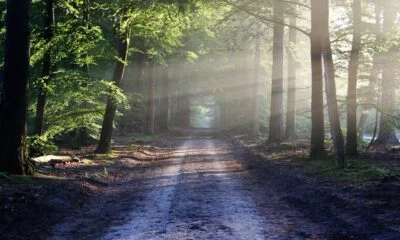
Ways Preserving the Natural Environment Fights Anxiety

Exploring the Future of Food Concerns in the Face of Climate Change
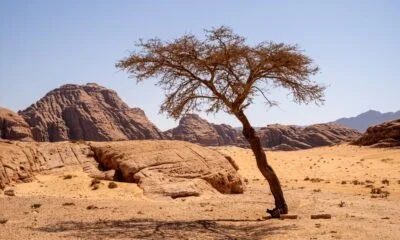
Tips to Prepare for Extreme Weather Caused by Climate Change

FoodTech Advances Can Feed the World Despite Climate Change
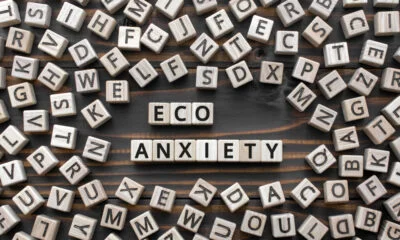
5 Coping Strategies for Anxiety Over Climate Change

Coffee Farms & Cloud Forests: Colombia’s New Eco Initiatives
Like our Facebook Page

4 Eco-Friendly Home Improvements for People with Disabilities

5 Tips for Making Your Home More Energy Efficient Now

Container Farming 101 for Eco-Friendly Farmers

How Cryptocurrency Traders Can Be Green and Still Make a Profit

Green Home Improvements to Improve Accessibility for Persons with Disabilities

Solar Power Breakthrough Creates a Future Powered by the Sun

Should Green Influencers Use Alua To Build a Fan Club?

Jinko Solar’s Charitable Contributions Across the US

Your Dream of Having an Eco-Friendly Bathroom Is Within Reach

What is the Eco-Friendliest Option to Wash Your Dishes?

5 Ways Fleet Maintenance Software Can Help Businesses Be More Eco-Friendly

Addressing Pressing Ethical Concerns with Crypto Exchanges
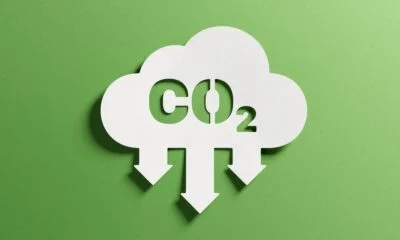
10 Tax Incentives for Businesses That are Lowering their Carbon Footprint
ENCYCLOPEDIC ENTRY
Climate change.
Climate change is a long-term shift in global or regional climate patterns. Often climate change refers specifically to the rise in global temperatures from the mid-20th century to present.
Earth Science, Climatology
Fracking tower
Fracking is a controversial form of drilling that uses high-pressure liquid to create cracks in underground shale to extract natural gas and petroleum. Carbon emissions from fossils fuels like these have been linked to global warming and climate change.
Photograph by Mark Thiessen / National Geographic

Climate is sometimes mistaken for weather. But climate is different from weather because it is measured over a long period of time, whereas weather can change from day to day, or from year to year. The climate of an area includes seasonal temperature and rainfall averages, and wind patterns. Different places have different climates. A desert, for example, is referred to as an arid climate because little water falls, as rain or snow, during the year. Other types of climate include tropical climates, which are hot and humid , and temperate climates, which have warm summers and cooler winters.
Climate change is the long-term alteration of temperature and typical weather patterns in a place. Climate change could refer to a particular location or the planet as a whole. Climate change may cause weather patterns to be less predictable. These unexpected weather patterns can make it difficult to maintain and grow crops in regions that rely on farming because expected temperature and rainfall levels can no longer be relied on. Climate change has also been connected with other damaging weather events such as more frequent and more intense hurricanes, floods, downpours, and winter storms.
In polar regions, the warming global temperatures associated with climate change have meant ice sheets and glaciers are melting at an accelerated rate from season to season. This contributes to sea levels rising in different regions of the planet. Together with expanding ocean waters due to rising temperatures, the resulting rise in sea level has begun to damage coastlines as a result of increased flooding and erosion.
The cause of current climate change is largely human activity, like burning fossil fuels , like natural gas, oil, and coal. Burning these materials releases what are called greenhouse gases into Earth’s atmosphere . There, these gases trap heat from the sun’s rays inside the atmosphere causing Earth’s average temperature to rise. This rise in the planet's temperature is called global warming. The warming of the planet impacts local and regional climates. Throughout Earth's history, climate has continually changed. When occuring naturally, this is a slow process that has taken place over hundreds and thousands of years. The human influenced climate change that is happening now is occuring at a much faster rate.
Media Credits
The audio, illustrations, photos, and videos are credited beneath the media asset, except for promotional images, which generally link to another page that contains the media credit. The Rights Holder for media is the person or group credited.
Production Managers
Program specialists, last updated.
October 19, 2023
User Permissions
For information on user permissions, please read our Terms of Service. If you have questions about how to cite anything on our website in your project or classroom presentation, please contact your teacher. They will best know the preferred format. When you reach out to them, you will need the page title, URL, and the date you accessed the resource.
If a media asset is downloadable, a download button appears in the corner of the media viewer. If no button appears, you cannot download or save the media.
Text on this page is printable and can be used according to our Terms of Service .
Interactives
Any interactives on this page can only be played while you are visiting our website. You cannot download interactives.
Related Resources
Yale Program on Climate Change Communication
- About YPCCC
- Yale Climate Connections
- Student Employment
- For The Media
- Past Events
- YPCCC in the News
- Climate Change in the American Mind (CCAM)
- Publications
- Climate Opinion Maps
- Climate Opinion Factsheets
- Six Americas Super Short Survey (SASSY)
- Resources for Educators
- All Tools & Interactives
- Partner with YPCCC
Home / For Educators: Grades 6-12
For Educators: Grades 6-12
Climate change is a complex topic to teach. In addition to teaching the science behind climate change, it is critical to help students become effective climate change communicators.
We have developed materials for teachers who are interested in using our resources in their classrooms, such as the Yale Climate Opinion Maps and Yale Climate Connections. These materials were developed based on recommendations from educators across the United States. They aim to immerse students in climate change issues in an accessible, digestible, and interactive way. While these NGSS and Common Core-aligned activities were designed for middle and high schoolers, you can easily convert them to Word documents using free platforms like https://simplypdf.com/ so that you can customize them for your students. We’d also love to hear about your experience using our materials with your students! Please fill out this brief survey .
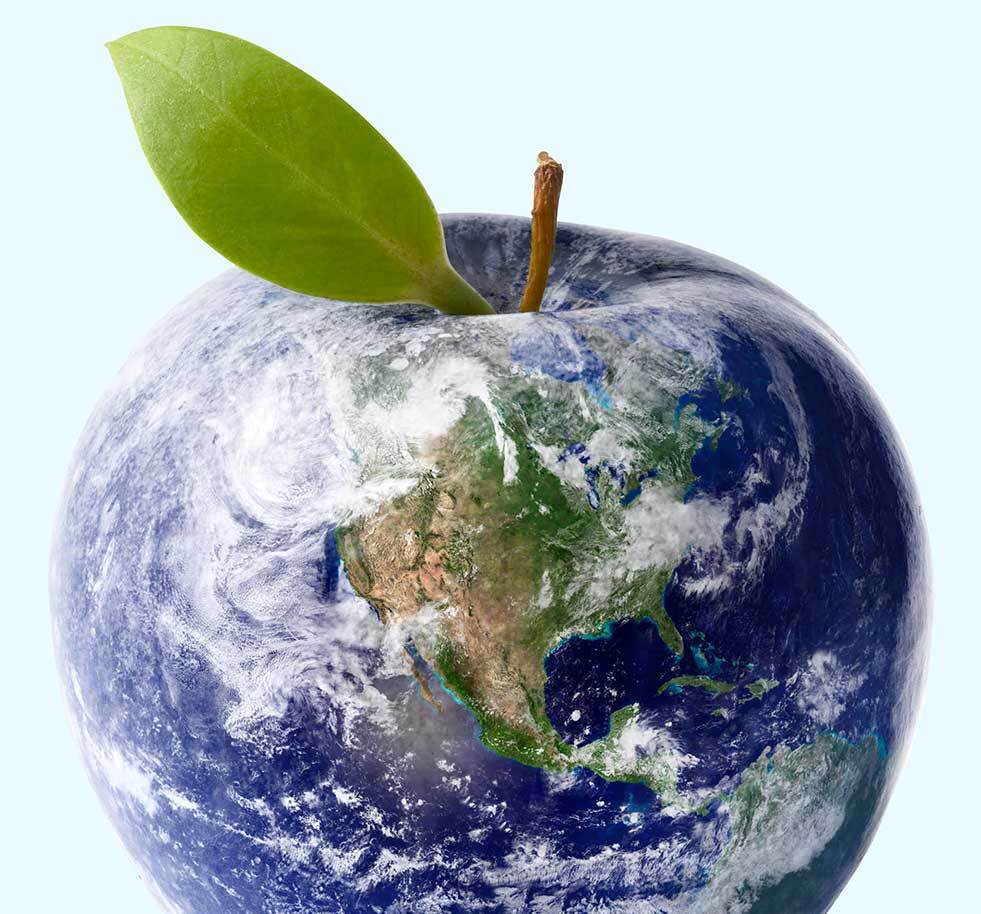
- Audio Story
Backgrounders for Educators
- Climate Change Audiences
- Interactive Maps
- Intermediate
- Introductory

Climate Change Basics: Five Facts, Ten Words
To simplify the scientific complexity of climate change, we focus on communicating five key facts about climate change that everyone should know.

Climate Change Communication Investigation
Advanced Interactive Maps
The Yale Climate Opinion Maps help us compare Americans’ beliefs around climate change across different parts of the country. For this project, students will get to be researchers collecting data in their own communities, just like the researchers at YPCCC.

Climate Change Jigsaw
Introductory Audio Story
This Jigsaw exercise offers two ways in which students can discuss our radio stories as a team to deepen thinking around climate change issues.

Climate Explained: Introductory Essays About Climate Change Topics
Climate Explained, a part of Yale Climate Connections, is an essay collection that addresses an array of climate change questions and topics, including why it’s cold outside if global warming is real, how we know that humans are responsible for global warming, and the relationship between climate change and national security.

Connecting Data to Storytelling
Advanced Audio Story
There are many ways to tell stories. We can write, speak, or even use art to tell a story. Data can tell a story, too. In this activity, students will draw connections between a Yale Climate Connections radio story and data from the Yale Climate Opinion Maps.

Decoding the Data
Intermediate Climate Change Audiences
This activity is inspired by the New York Times What’s Going On in This Graph? feature and offers students the chance to practice their data interpretation skills.

External Resources
Looking for resources to help you and your students build a solid climate change science foundation? We’ve compiled a list of reputable, student-friendly links to help you do just that!

Meet Global Warming’s Six Americas
Introductory Climate Change Audiences
Our research has identified “Global Warming’s Six Americas” as six unique audiences within the American public that each responds to the issue of climate change in a distinct way. Introduce Global Warming’s Six Americas to your students with this text.

Navigating the Yale Climate Opinion Maps
Intermediate Interactive Maps
The Yale Climate Opinion Maps tool is a way to explore how Americans’ climate change beliefs vary across the country. Navigating the Yale Climate Opinion Maps is a question guide that will help students use this interactive tool.

Question Bank
Use this Question Bank as a guide to discuss any of our 90-second daily podcasts! These questions can help start a full class conversation, be used in small group discussion, or function as writing prompts.

Re-representing a Climate Change Story
Intermediate Audio Story
Stories can build understanding around a topic and can also help students explore connections between classroom content and their own lives. In this activity, students will get to be the storyteller and will choose how they would like to retell one of our radio stories.

Role Play: Six Americas, Six Views on Global Warming
Advanced Climate Change Audiences
An important part of stopping climate change is being able to communicate with people who may have different opinions about it. This is an exercise to help students practice engaging with people of varying perspectives.

What is a Survey?
This annotated list of links can be used to teach your students about surveying in general and scientific polling in particular. These resources can help answer questions about what polls are, why we use polling and surveying, and what reliable survey data shows us.

Why should we care about climate change?
Having different perspectives about global warming is natural, but the most important thing that anyone should know about climate change is why it matters.
Subscribe to our mailing list
Please select all the ways you would like to hear from Yale Program on Climate Change Communication:
You can unsubscribe at any time by clicking the link in the footer of our emails. For information about our privacy practices, please visit our website.
We use Mailchimp as our marketing platform. By clicking below to subscribe, you acknowledge that your information will be transferred to Mailchimp for processing. Learn more about Mailchimp's privacy practices here.

What Is Climate Change?
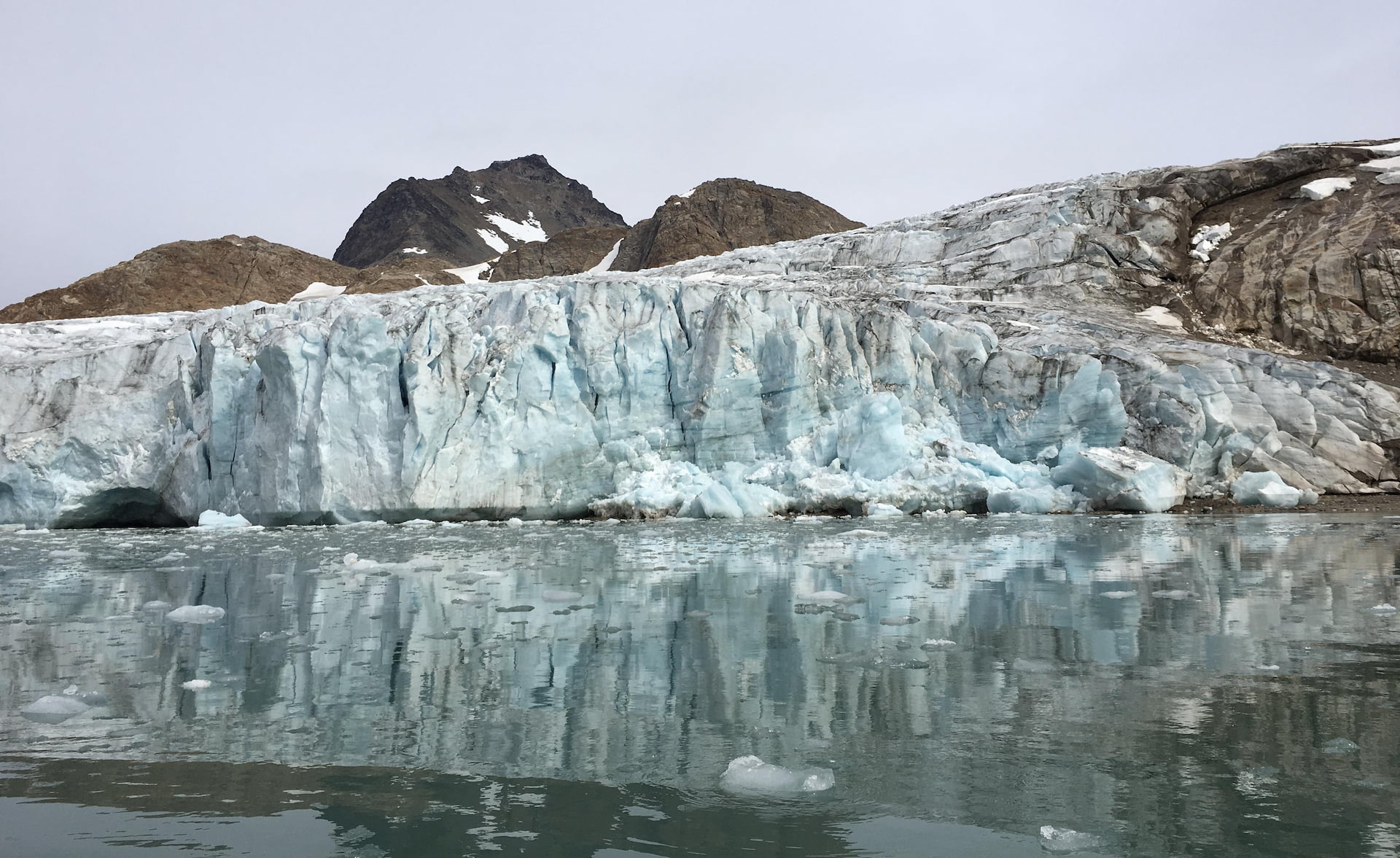
Climate change is a long-term change in the average weather patterns that have come to define Earth’s local, regional and global climates. These changes have a broad range of observed effects that are synonymous with the term.
Changes observed in Earth’s climate since the mid-20th century are driven by human activities, particularly fossil fuel burning, which increases heat-trapping greenhouse gas levels in Earth’s atmosphere, raising Earth’s average surface temperature. Natural processes, which have been overwhelmed by human activities, can also contribute to climate change, including internal variability (e.g., cyclical ocean patterns like El Niño, La Niña and the Pacific Decadal Oscillation) and external forcings (e.g., volcanic activity, changes in the Sun’s energy output , variations in Earth’s orbit ).
Scientists use observations from the ground, air, and space, along with computer models , to monitor and study past, present, and future climate change. Climate data records provide evidence of climate change key indicators, such as global land and ocean temperature increases; rising sea levels; ice loss at Earth’s poles and in mountain glaciers; frequency and severity changes in extreme weather such as hurricanes, heatwaves, wildfires, droughts, floods, and precipitation; and cloud and vegetation cover changes.
“Climate change” and “global warming” are often used interchangeably but have distinct meanings. Similarly, the terms "weather" and "climate" are sometimes confused, though they refer to events with broadly different spatial- and timescales.

What Is Global Warming?
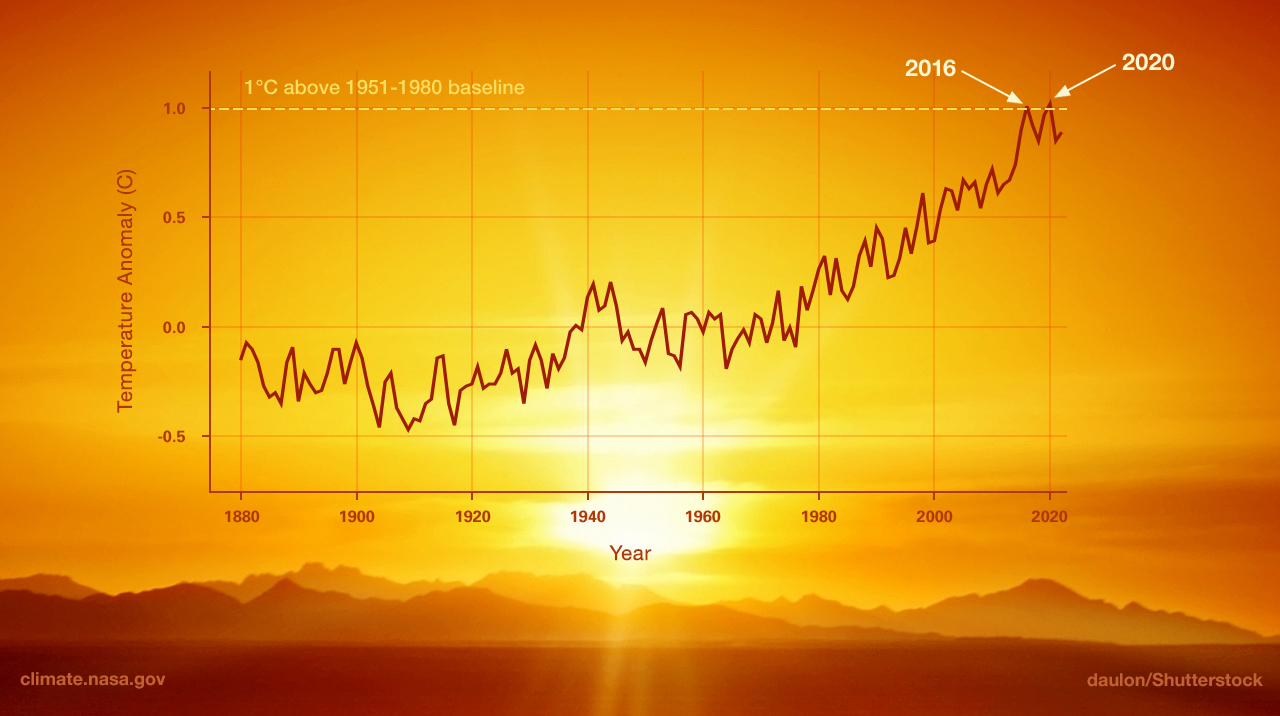
Global warming is the long-term heating of Earth’s surface observed since the pre-industrial period (between 1850 and 1900) due to human activities, primarily fossil fuel burning, which increases heat-trapping greenhouse gas levels in Earth’s atmosphere. This term is not interchangeable with the term "climate change."
Since the pre-industrial period, human activities are estimated to have increased Earth’s global average temperature by about 1 degree Celsius (1.8 degrees Fahrenheit), a number that is currently increasing by more than 0.2 degrees Celsius (0.36 degrees Fahrenheit) per decade. The current warming trend is unequivocally the result of human activity since the 1950s and is proceeding at an unprecedented rate over millennia.
Weather vs. Climate
“if you don’t like the weather in new england, just wait a few minutes.” - mark twain.
Weather refers to atmospheric conditions that occur locally over short periods of time—from minutes to hours or days. Familiar examples include rain, snow, clouds, winds, floods, or thunderstorms.
Climate, on the other hand, refers to the long-term (usually at least 30 years) regional or even global average of temperature, humidity, and rainfall patterns over seasons, years, or decades.
Find Out More: A Guide to NASA’s Global Climate Change Website
This website provides a high-level overview of some of the known causes, effects and indications of global climate change:
Evidence. Brief descriptions of some of the key scientific observations that our planet is undergoing abrupt climate change.
Causes. A concise discussion of the primary climate change causes on our planet.
Effects. A look at some of the likely future effects of climate change, including U.S. regional effects.
Vital Signs. Graphs and animated time series showing real-time climate change data, including atmospheric carbon dioxide, global temperature, sea ice extent, and ice sheet volume.
Earth Minute. This fun video series explains various Earth science topics, including some climate change topics.
Other NASA Resources
Goddard Scientific Visualization Studio. An extensive collection of animated climate change and Earth science visualizations.
Sea Level Change Portal. NASA's portal for an in-depth look at the science behind sea level change.
NASA’s Earth Observatory. Satellite imagery, feature articles and scientific information about our home planet, with a focus on Earth’s climate and environmental change.
Header image is of Apusiaajik Glacier, and was taken near Kulusuk, Greenland, on Aug. 26, 2018, during NASA's Oceans Melting Greenland (OMG) field operations. Learn more here . Credit: NASA/JPL-Caltech
Discover More Topics From NASA
Explore Earth Science

Earth Science in Action

Earth Science Data

Facts About Earth

- CBSE Class 10th
- CBSE Class 12th
- UP Board 10th
- UP Board 12th
- Bihar Board 10th
- Bihar Board 12th
- Top Schools in India
- Top Schools in Delhi
- Top Schools in Mumbai
- Top Schools in Chennai
- Top Schools in Hyderabad
- Top Schools in Kolkata
- Top Schools in Pune
- Top Schools in Bangalore
Products & Resources
- JEE Main Knockout April
- Free Sample Papers
- Free Ebooks
- NCERT Notes
- NCERT Syllabus
- NCERT Books
- RD Sharma Solutions
- Navodaya Vidyalaya Admission 2024-25
- NCERT Solutions
- NCERT Solutions for Class 12
- NCERT Solutions for Class 11
- NCERT solutions for Class 10
- NCERT solutions for Class 9
- NCERT solutions for Class 8
- NCERT Solutions for Class 7
- JEE Main 2024
- MHT CET 2024
- JEE Advanced 2024
- BITSAT 2024
- View All Engineering Exams
- Colleges Accepting B.Tech Applications
- Top Engineering Colleges in India
- Engineering Colleges in India
- Engineering Colleges in Tamil Nadu
- Engineering Colleges Accepting JEE Main
- Top IITs in India
- Top NITs in India
- Top IIITs in India
- JEE Main College Predictor
- JEE Main Rank Predictor
- MHT CET College Predictor
- AP EAMCET College Predictor
- GATE College Predictor
- KCET College Predictor
- JEE Advanced College Predictor
- View All College Predictors
- JEE Main Question Paper
- JEE Main Cutoff
- JEE Main Advanced Admit Card
- JEE Advanced Admit Card 2024
- Download E-Books and Sample Papers
- Compare Colleges
- B.Tech College Applications
- KCET Result
- MAH MBA CET Exam
- View All Management Exams
Colleges & Courses
- MBA College Admissions
- MBA Colleges in India
- Top IIMs Colleges in India
- Top Online MBA Colleges in India
- MBA Colleges Accepting XAT Score
- BBA Colleges in India
- XAT College Predictor 2024
- SNAP College Predictor
- NMAT College Predictor
- MAT College Predictor 2024
- CMAT College Predictor 2024
- CAT Percentile Predictor 2023
- CAT 2023 College Predictor
- CMAT 2024 Admit Card
- TS ICET 2024 Hall Ticket
- CMAT Result 2024
- MAH MBA CET Cutoff 2024
- Download Helpful Ebooks
- List of Popular Branches
- QnA - Get answers to your doubts
- IIM Fees Structure
- AIIMS Nursing
- Top Medical Colleges in India
- Top Medical Colleges in India accepting NEET Score
- Medical Colleges accepting NEET
- List of Medical Colleges in India
- List of AIIMS Colleges In India
- Medical Colleges in Maharashtra
- Medical Colleges in India Accepting NEET PG
- NEET College Predictor
- NEET PG College Predictor
- NEET MDS College Predictor
- NEET Rank Predictor
- DNB PDCET College Predictor
- NEET Admit Card 2024
- NEET PG Application Form 2024
- NEET Cut off
- NEET Online Preparation
- Download Helpful E-books
- Colleges Accepting Admissions
- Top Law Colleges in India
- Law College Accepting CLAT Score
- List of Law Colleges in India
- Top Law Colleges in Delhi
- Top NLUs Colleges in India
- Top Law Colleges in Chandigarh
- Top Law Collages in Lucknow
Predictors & E-Books
- CLAT College Predictor
- MHCET Law ( 5 Year L.L.B) College Predictor
- AILET College Predictor
- Sample Papers
- Compare Law Collages
- Careers360 Youtube Channel
- CLAT Syllabus 2025
- CLAT Previous Year Question Paper
- NID DAT Exam
- Pearl Academy Exam
Predictors & Articles
- NIFT College Predictor
- UCEED College Predictor
- NID DAT College Predictor
- NID DAT Syllabus 2025
- NID DAT 2025
- Design Colleges in India
- Top NIFT Colleges in India
- Fashion Design Colleges in India
- Top Interior Design Colleges in India
- Top Graphic Designing Colleges in India
- Fashion Design Colleges in Delhi
- Fashion Design Colleges in Mumbai
- Top Interior Design Colleges in Bangalore
- NIFT Result 2024
- NIFT Fees Structure
- NIFT Syllabus 2025
- Free Design E-books
- List of Branches
- Careers360 Youtube channel
- IPU CET BJMC
- JMI Mass Communication Entrance Exam
- IIMC Entrance Exam
- Media & Journalism colleges in Delhi
- Media & Journalism colleges in Bangalore
- Media & Journalism colleges in Mumbai
- List of Media & Journalism Colleges in India
- CA Intermediate
- CA Foundation
- CS Executive
- CS Professional
- Difference between CA and CS
- Difference between CA and CMA
- CA Full form
- CMA Full form
- CS Full form
- CA Salary In India
Top Courses & Careers
- Bachelor of Commerce (B.Com)
- Master of Commerce (M.Com)
- Company Secretary
- Cost Accountant
- Charted Accountant
- Credit Manager
- Financial Advisor
- Top Commerce Colleges in India
- Top Government Commerce Colleges in India
- Top Private Commerce Colleges in India
- Top M.Com Colleges in Mumbai
- Top B.Com Colleges in India
- IT Colleges in Tamil Nadu
- IT Colleges in Uttar Pradesh
- MCA Colleges in India
- BCA Colleges in India
Quick Links
- Information Technology Courses
- Programming Courses
- Web Development Courses
- Data Analytics Courses
- Big Data Analytics Courses
- RUHS Pharmacy Admission Test
- Top Pharmacy Colleges in India
- Pharmacy Colleges in Pune
- Pharmacy Colleges in Mumbai
- Colleges Accepting GPAT Score
- Pharmacy Colleges in Lucknow
- List of Pharmacy Colleges in Nagpur
- GPAT Result
- GPAT 2024 Admit Card
- GPAT Question Papers
- NCHMCT JEE 2024
- Mah BHMCT CET
- Top Hotel Management Colleges in Delhi
- Top Hotel Management Colleges in Hyderabad
- Top Hotel Management Colleges in Mumbai
- Top Hotel Management Colleges in Tamil Nadu
- Top Hotel Management Colleges in Maharashtra
- B.Sc Hotel Management
- Hotel Management
- Diploma in Hotel Management and Catering Technology
Diploma Colleges
- Top Diploma Colleges in Maharashtra
- UPSC IAS 2024
- SSC CGL 2024
- IBPS RRB 2024
- Previous Year Sample Papers
- Free Competition E-books
- Sarkari Result
- QnA- Get your doubts answered
- UPSC Previous Year Sample Papers
- CTET Previous Year Sample Papers
- SBI Clerk Previous Year Sample Papers
- NDA Previous Year Sample Papers
Upcoming Events
- NDA Application Form 2024
- UPSC IAS Application Form 2024
- CDS Application Form 2024
- CTET Admit card 2024
- HP TET Result 2023
- SSC GD Constable Admit Card 2024
- UPTET Notification 2024
- SBI Clerk Result 2024
Other Exams
- SSC CHSL 2024
- UP PCS 2024
- UGC NET 2024
- RRB NTPC 2024
- IBPS PO 2024
- IBPS Clerk 2024
- IBPS SO 2024
- Top University in USA
- Top University in Canada
- Top University in Ireland
- Top Universities in UK
- Top Universities in Australia
- Best MBA Colleges in Abroad
- Business Management Studies Colleges
Top Countries
- Study in USA
- Study in UK
- Study in Canada
- Study in Australia
- Study in Ireland
- Study in Germany
- Study in China
- Study in Europe
Student Visas
- Student Visa Canada
- Student Visa UK
- Student Visa USA
- Student Visa Australia
- Student Visa Germany
- Student Visa New Zealand
- Student Visa Ireland
- CUET PG 2024
- IGNOU B.Ed Admission 2024
- DU Admission 2024
- UP B.Ed JEE 2024
- LPU NEST 2024
- IIT JAM 2024
- IGNOU Online Admission 2024
- Universities in India
- Top Universities in India 2024
- Top Colleges in India
- Top Universities in Uttar Pradesh 2024
- Top Universities in Bihar
- Top Universities in Madhya Pradesh 2024
- Top Universities in Tamil Nadu 2024
- Central Universities in India
- CUET Exam City Intimation Slip 2024
- IGNOU Date Sheet
- CUET Mock Test 2024
- CUET Admit card 2024
- CUET PG Syllabus 2024
- CUET Participating Universities 2024
- CUET Previous Year Question Paper
- CUET Syllabus 2024 for Science Students
- E-Books and Sample Papers
- CUET Exam Pattern 2024
- CUET Exam Date 2024
- CUET Cut Off 2024
- CUET Exam Analysis 2024
- IGNOU Exam Form 2024
- CUET 2024 Exam Live
- CUET Answer Key 2024
Engineering Preparation
- Knockout JEE Main 2024
- Test Series JEE Main 2024
- JEE Main 2024 Rank Booster
Medical Preparation
- Knockout NEET 2024
- Test Series NEET 2024
- Rank Booster NEET 2024
Online Courses
- JEE Main One Month Course
- NEET One Month Course
- IBSAT Free Mock Tests
- IIT JEE Foundation Course
- Knockout BITSAT 2024
- Career Guidance Tool
Top Streams
- IT & Software Certification Courses
- Engineering and Architecture Certification Courses
- Programming And Development Certification Courses
- Business and Management Certification Courses
- Marketing Certification Courses
- Health and Fitness Certification Courses
- Design Certification Courses
Specializations
- Digital Marketing Certification Courses
- Cyber Security Certification Courses
- Artificial Intelligence Certification Courses
- Business Analytics Certification Courses
- Data Science Certification Courses
- Cloud Computing Certification Courses
- Machine Learning Certification Courses
- View All Certification Courses
- UG Degree Courses
- PG Degree Courses
- Short Term Courses
- Free Courses
- Online Degrees and Diplomas
- Compare Courses
Top Providers
- Coursera Courses
- Udemy Courses
- Edx Courses
- Swayam Courses
- upGrad Courses
- Simplilearn Courses
- Great Learning Courses
Essay on Climate Change
Climate Change Essay - The globe is growing increasingly sensitive to climate change. It is currently a serious worldwide concern. The term "Climate Change" describes changes to the earth's climate. It explains the atmospheric changes that have occurred across time, spanning from decades to millions of years. Here are some sample essays on climate change.
100 Words Essay on Climate Change
200 words essay on climate change, 500 words essay on climate change.

The climatic conditions on Earth are changing due to climate change. Several internal and external variables, such as solar radiation, variations in the Earth's orbit, volcanic eruptions, plate tectonics, etc., are to blame for this.
There are strategies for climate change reduction. If not implemented, the weather might get worse, there might be water scarcity, there could be lower agricultural output, and it might affect people's ability to make a living. In order to breathe clean air and drink pure water, you must concentrate on limiting human activity. These are the simple measures that may be taken to safeguard the environment and its resources.
The climate of the Earth has changed significantly over time. While some of these changes were brought on by natural events like volcanic eruptions, floods, forest fires, etc., many of the changes were brought on by human activity. The burning of fossil fuels, domesticating livestock, and other human activities produce a significant quantity of greenhouse gases. This results in an increase of greenhouse effect and global warming which are the major causes for climate change.
Reasons of Climate Change
Some of the reasons of climate change are:
Deforestation
Excessive use of fossil fuels
Water and soil pollution
Plastic and other non biodegradable waste
Wildlife and nature extinction
Consequences of Climate Change
All kinds of life on earth will be affected by climate change if it continues to change at the same pace. The earth's temperature will increase, the monsoon patterns will shift, the sea level will rise, and there will be more frequent storms, volcano eruptions, and other natural calamities. The earth's biological and ecological equilibrium will be disturbed. Humans won't be able to access clean water or air to breathe when the environment becomes contaminated. The end of life on this earth is imminent. To reduce the issue of climate change, we need to bring social awareness along with strict measures to protect and preserve the natural environment.
A shift in the world's climatic pattern is referred to as climate change. Over the centuries, the climate pattern of our planet has undergone modifications. The amount of carbon dioxide in the atmosphere has significantly grown.
When Did Climate Change Begin
It is possible to see signs of climate change as early as the beginning of the industrial revolution. The pace at which the manufacturers produced things on a large scale required a significant amount of raw materials. Since the raw materials being transformed into finished products now have such huge potential for profit, these business models have spread quickly over the world. Hazardous substances and chemicals build up in the environment as a result of company emissions and waste disposal.
Although climate change is a natural occurrence, it is evident that human activity is turning into the primary cause of the current climate change situation. The major cause is the growing population. Natural resources are utilised more and more as a result of the population's fast growth placing a heavy burden on the available resources. Over time, as more and more products and services are created, pollution will eventually increase.
Causes of Climate Change
There are a number of factors that have contributed towards weather change in the past and continue to do so. Let us look at a few:
Solar Radiation |The climate of earth is determined by how quickly the sun's energy is absorbed and distributed throughout space. This energy is transmitted throughout the world by the winds, ocean currents etc which affects the climatic conditions of the world. Changes in solar intensity have an effect on the world's climate.
Deforestation | The atmosphere's carbon dioxide is stored by trees. As a result of their destruction, carbon dioxide builds up more quickly since there are no trees to absorb it. Additionally, trees release the carbon they stored when we burn them.
Agriculture | Many kinds of greenhouse gases are released into the atmosphere by growing crops and raising livestock. Animals, for instance, create methane, a greenhouse gas that is 30 times more potent than carbon dioxide. The nitrous oxide used in fertilisers is roughly 300 times more strong than carbon dioxide.
How to Prevent Climate Change
We need to look out for drastic steps to stop climate change since it is affecting the resources and life on our planet. We can stop climate change if the right solutions are put in place. Here are some strategies for reducing climate change:
Raising public awareness of climate change
Prohibiting tree-cutting and deforestation.
Ensure the surroundings are clean.
Refrain from using chemical fertilisers.
Water and other natural resource waste should be reduced.
Protect the animals and plants.
Purchase energy-efficient goods and equipment.
Increase the number of trees in the neighbourhood and its surroundings.
Follow the law and safeguard the environment's resources.
Reduce the amount of energy you use.
During the last few decades especially, climate change has grown to be of concern. Global concern has been raised over changes in the Earth's climatic pattern. The causes of climate change are numerous, as well as the effects of it and it is our responsibility as inhabitants of this planet to look after its well being and leave it in a better condition for future generations.
Applications for Admissions are open.

Aakash iACST Scholarship Test 2024
Get up to 90% scholarship on NEET, JEE & Foundation courses

ALLEN Digital Scholarship Admission Test (ADSAT)
Register FREE for ALLEN Digital Scholarship Admission Test (ADSAT)

JEE Main Important Physics formulas
As per latest 2024 syllabus. Physics formulas, equations, & laws of class 11 & 12th chapters

PW JEE Coaching
Enrol in PW Vidyapeeth center for JEE coaching

PW NEET Coaching
Enrol in PW Vidyapeeth center for NEET coaching

JEE Main Important Chemistry formulas
As per latest 2024 syllabus. Chemistry formulas, equations, & laws of class 11 & 12th chapters
Download Careers360 App's
Regular exam updates, QnA, Predictors, College Applications & E-books now on your Mobile
Certifications
We Appeared in
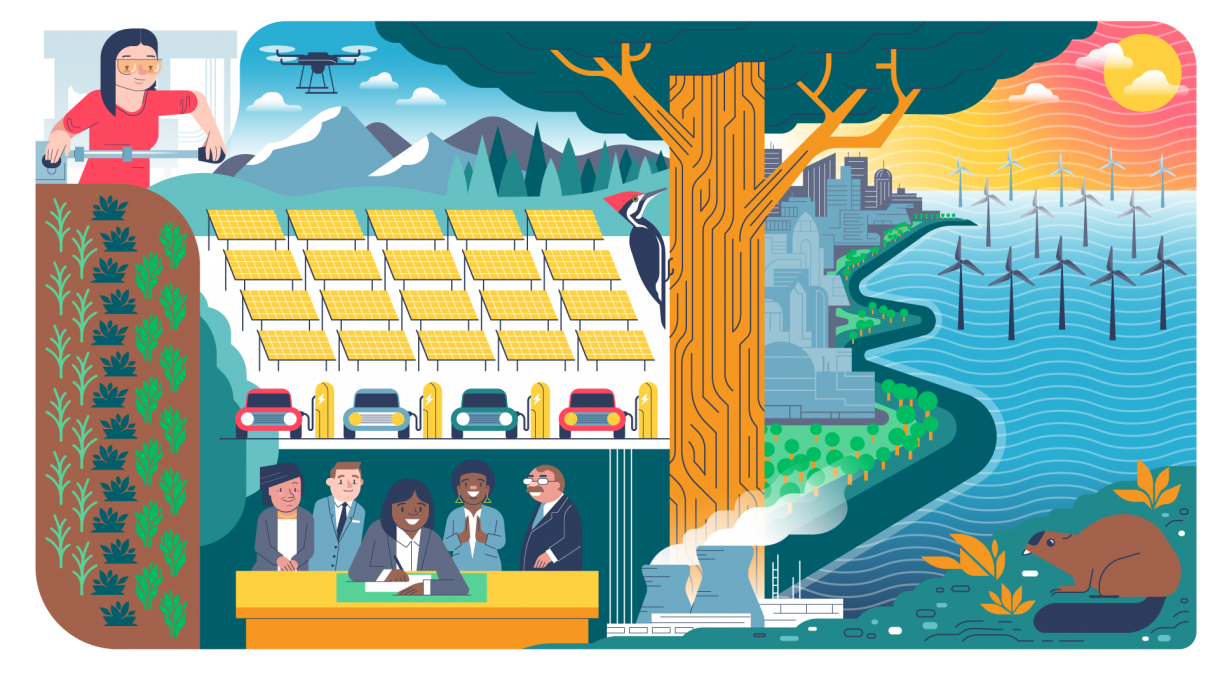
New to Climate Change?
What can be done about climate change.
It is not too late to take action on climate change.
The Science
Given what we know about the threats that climate change poses to humans, we must take swift action. As a global community, we need to soon level off—and then decrease—the amount of carbon dioxide (CO 2 ) and other greenhouse gases in the atmosphere. The faster we do this, the less damage we will cause to our world and our way of life.
Stopping the Rise in CO2
The fastest way to address the buildup of CO 2 in the atmosphere is to stop adding more. Many vital parts of our economy emit huge amounts of greenhouse gases: the way we generate electricity and heat for our buildings and industry; the oil we burn to power our cars, trucks and planes; the refrigerants we use to preserve our food and cool our buildings; and the intensive manufacturing processes for making concrete and steel .
And yet there are many ways to reduce the CO 2 from these sectors. We can replace high-emitting fuels like coal, oil and gas with nearly “carbon-free” alternatives, such as solar power , wind power , or nuclear power . We can capture the CO 2 from fossil fuel power and manufacturing plants and store it underground. We can also update our buildings and infrastructure, so that it takes less energy to build and use them.
We can add to these efforts by trying to remove some of the CO 2 that is already in the atmosphere: for instance, by reforesting the Earth, by changing our farming practices to store more carbon in the soil , or through “direct air capture” technology. However, these methods will likely not be able to remove CO 2 quicker than we are now adding it to the atmosphere. We must begin with stopping our runaway greenhouse gas emissions.
Adapting to Change
Because human activity has already added such a large amount of greenhouse gases to the atmosphere, the world is now experiencing the early effects of climate change. We need to prepare for and adapt to these changes, so that we can protect human health, water and food supplies, our cities and towns , and natural habitats. A new field of work has emerged to reinforce coastlines to shield them from rising oceans , grow new crops to match regions’ changing climates, protect our infrastructure from wildfires and hurricanes , and plan for shifting supplies of water and food.
Today, these tasks are still manageable. If we get ahead of the regional changes we know are coming, and if we put the needs of the poorest and most vulnerable first, very few parts of the world will be irreparably damaged by the climate change we have already caused.
But unless we also actively cut our greenhouse gas emissions, unchecked climate change could eventually put safe and just adaptation beyond our reach. This possibility has led some scientists to study more extreme and controversial options, like geoengineering; for example, there are proposals that would try to artificially cool the Earth to counter some of the effects of climate change. Urgent action is needed to avoid the need for these riskier options.
Driving Solutions
Great progress can and must be achieved with the low-carbon technologies we have today. And all of us can help speed the pace at which these technologies take root and spread. Individuals can change their behavior and advocate for ambitious new policies. Corporations can drive change across whole industries. Governments can enact laws to make it easier and cheaper to cut greenhouse gas emissions, and to help communities prepare for new challenges. And intergovernmental agreements such as the Paris Agreement have already created a strong framework for international cooperation and aggressive action, if governments around the world step up their commitments .
At the same time, the world does not have a true alternative to fossil fuels that can meet all our current energy needs, let alone meet an increased demand in the future. We severely lack the suite of solutions to address climate change at an economic and social cost that we can agree to bear.
A tremendous amount of work is taking place at MIT and other scientific and engineering institutions around the world to develop these options, in collaboration with the industries and communities that can deploy and scale them. But to quicken the pace of technological breakthroughs, policymakers need to set the stage now for game-changing advances in multiple fields of science, technology, and policy. To take on the hardest challenges in reducing our emissions, in removing CO 2 from the atmosphere, and in adapting to a changing climate, we urgently need new tools.
Seizing the Opportunity
The MIT community fundamentally agrees that climate change presents grave risks that demand society’s urgent attention. The challenge requires an aggressive and pragmatic plan to achieve a net zero carbon global energy system, the sooner the better, for all of humankind.
If academia, business, government, and citizens act together toward this common goal, we can create a pollution-free energy system; form a prosperous, adaptable and resilient society; keep human, animal, and plant life flourishing; and create a better world for ourselves and generations to come.
You may notice that we, the writers on this site, use the word “we” to collectively refer to those who have benefitted in various ways from burning fossil fuels, those who will face the impacts of climate change, and those whose responsibility it is to act. We did this intentionally to create a sense of community in addressing this challenge. However, we acknowledge that people and groups across the globe have not equally benefitted from the use of fossil fuels, and many – including young people and future generations – will disproportionately endure the consequences. We, those who are affiliated with MIT and those who live in developed countries, are often among those whose activities have historically had a disproportionate impact on climate change. Therefore, we see that we have a greater responsibility – as professionals, citizens, community members, and consumers – to act to reverse its course.
Beef up your knowledge on specific climate change impacts and solutions with our quick explanations about clean energy, climate models, and much more, written by MIT experts.
Have Questions?
Whether it's simple or sticky, about science or solutions, ask us! We work with MIT faculty and scientists to get you clear, no-nonsense answers grounded in the best scientific information.
Tinker Around
Create your own set of climate change solutions in this online simulator from Climate Interactive and MIT Sloan’s Sustainability Initiative.
Take a Course
Extend your learning with edX's online courses on clean energy, food security, sustainable architecture, protecting health and many more.
Collections of news, posts, and research around major climate science topics.

The Paris Agreement

Renewable Energy

Carbon Pricing
Mit climate news in your inbox.

30,000+ students realised their study abroad dream with us. Take the first step today
Here’s your new year gift, one app for all your, study abroad needs, start your journey, track your progress, grow with the community and so much more.

Verification Code
An OTP has been sent to your registered mobile no. Please verify

Thanks for your comment !
Our team will review it before it's shown to our readers.

Essay on Global Warming
- Updated on
- Apr 27, 2024

Being able to write an essay is an integral part of mastering any language. Essays form an integral part of many academic and scholastic exams like the SAT , and UPSC amongst many others. It is a crucial evaluative part of English proficiency tests as well like IELTS , TOEFL , etc. Major essays are meant to emphasize public issues of concern that can have significant consequences on the world. To understand the concept of Global Warming and its causes and effects, we must first examine the many factors that influence the planet’s temperature and what this implies for the world’s future. Here’s an unbiased look at the essay on Global Warming and other essential related topics.
Short Essay on Global Warming and Climate Change?
Since the industrial and scientific revolutions, Earth’s resources have been gradually depleted. Furthermore, the start of the world’s population’s exponential expansion is particularly hard on the environment. Simply put, as the population’s need for consumption grows, so does the use of natural resources , as well as the waste generated by that consumption.
Climate change has been one of the most significant long-term consequences of this. Climate change is more than just the rise or fall of global temperatures; it also affects rain cycles, wind patterns, cyclone frequencies, sea levels, and other factors. It has an impact on all major life groupings on the planet.
Also Read: World Population Day
What is Global Warming?
Global warming is the unusually rapid increase in Earth’s average surface temperature over the past century, primarily due to the greenhouse gases released by people burning fossil fuels . The greenhouse gases consist of methane, nitrous oxide, ozone, carbon dioxide, water vapour, and chlorofluorocarbons. The weather prediction has been becoming more complex with every passing year, with seasons more indistinguishable, and the general temperatures hotter.
The number of hurricanes, cyclones, droughts, floods, etc., has risen steadily since the onset of the 21st century. The supervillain behind all these changes is Global Warming. The name is quite self-explanatory; it means the rise in the temperature of the Earth.
Also Read: What is a Natural Disaster?
What are the Causes of Global Warming?
According to recent studies, many scientists believe the following are the primary four causes of global warming:
- Deforestation
- Greenhouse emissions
- Carbon emissions per capita
Extreme global warming is causing natural disasters , which can be seen all around us. One of the causes of global warming is the extreme release of greenhouse gases that become trapped on the earth’s surface, causing the temperature to rise. Similarly, volcanoes contribute to global warming by spewing excessive CO2 into the atmosphere.
The increase in population is one of the major causes of Global Warming. This increase in population also leads to increased air pollution . Automobiles emit a lot of CO2, which remains in the atmosphere. This increase in population is also causing deforestation, which contributes to global warming.
The earth’s surface emits energy into the atmosphere in the form of heat, keeping the balance with the incoming energy. Global warming depletes the ozone layer, bringing about the end of the world. There is a clear indication that increased global warming will result in the extinction of all life on Earth’s surface.
Also Read: Land, Soil, Water, Natural Vegetation, and Wildlife Resources
Solutions for Global Warming
Of course, industries and multinational conglomerates emit more carbon than the average citizen. Nonetheless, activism and community effort are the only viable ways to slow the worsening effects of global warming. Furthermore, at the state or government level, world leaders must develop concrete plans and step-by-step programmes to ensure that no further harm is done to the environment in general.
Although we are almost too late to slow the rate of global warming, finding the right solution is critical. Everyone, from individuals to governments, must work together to find a solution to Global Warming. Some of the factors to consider are pollution control, population growth, and the use of natural resources.
One very important contribution you can make is to reduce your use of plastic. Plastic is the primary cause of global warming, and recycling it takes years. Another factor to consider is deforestation, which will aid in the control of global warming. More tree planting should be encouraged to green the environment. Certain rules should also govern industrialization. Building industries in green zones that affect plants and species should be prohibited.
Also Read: Essay on Pollution
Effects of Global Warming
Global warming is a real problem that many people want to disprove to gain political advantage. However, as global citizens, we must ensure that only the truth is presented in the media.
This decade has seen a significant impact from global warming. The two most common phenomena observed are glacier retreat and arctic shrinkage. Glaciers are rapidly melting. These are clear manifestations of climate change.
Another significant effect of global warming is the rise in sea level. Flooding is occurring in low-lying areas as a result of sea-level rise. Many countries have experienced extreme weather conditions. Every year, we have unusually heavy rain, extreme heat and cold, wildfires, and other natural disasters.
Similarly, as global warming continues, marine life is being severely impacted. This is causing the extinction of marine species as well as other problems. Furthermore, changes are expected in coral reefs, which will face extinction in the coming years. These effects will intensify in the coming years, effectively halting species expansion. Furthermore, humans will eventually feel the negative effects of Global Warming.
Also Read: Concept of Sustainable Development
Sample Essays on Global Warming
Here are some sample essays on Global Warming:
Essay on Global Warming Paragraph in 100 – 150 words
Global Warming is caused by the increase of carbon dioxide levels in the earth’s atmosphere and is a result of human activities that have been causing harm to our environment for the past few centuries now. Global Warming is something that can’t be ignored and steps have to be taken to tackle the situation globally. The average temperature is constantly rising by 1.5 degrees Celsius over the last few years.
The best method to prevent future damage to the earth, cutting down more forests should be banned and Afforestation should be encouraged. Start by planting trees near your homes and offices, participate in events, and teach the importance of planting trees. It is impossible to undo the damage but it is possible to stop further harm.
Also Read: Social Forestry
Essay on Global Warming in 250 Words
Over a long period, it is observed that the temperature of the earth is increasing. This affected wildlife, animals, humans, and every living organism on earth. Glaciers have been melting, and many countries have started water shortages, flooding, and erosion and all this is because of global warming.
No one can be blamed for global warming except for humans. Human activities such as gases released from power plants, transportation, and deforestation have increased gases such as carbon dioxide, CFCs, and other pollutants in the earth’s atmosphere. The main question is how can we control the current situation and build a better world for future generations. It starts with little steps by every individual.
Start using cloth bags made from sustainable materials for all shopping purposes, instead of using high-watt lights use energy-efficient bulbs, switch off the electricity, don’t waste water, abolish deforestation and encourage planting more trees. Shift the use of energy from petroleum or other fossil fuels to wind and solar energy. Instead of throwing out the old clothes donate them to someone so that it is recycled.
Donate old books, don’t waste paper. Above all, spread awareness about global warming. Every little thing a person does towards saving the earth will contribute in big or small amounts. We must learn that 1% effort is better than no effort. Pledge to take care of Mother Nature and speak up about global warming.
Also Read: Types of Water Pollution
Essay on Global Warming in 500 Words
Global warming isn’t a prediction, it is happening! A person denying it or unaware of it is in the most simple terms complicit. Do we have another planet to live on? Unfortunately, we have been bestowed with this one planet only that can sustain life yet over the years we have turned a blind eye to the plight it is in. Global warming is not an abstract concept but a global phenomenon occurring ever so slowly even at this moment. Global Warming is a phenomenon that is occurring every minute resulting in a gradual increase in the Earth’s overall climate. Brought about by greenhouse gases that trap the solar radiation in the atmosphere, global warming can change the entire map of the earth, displacing areas, flooding many countries, and destroying multiple lifeforms. Extreme weather is a direct consequence of global warming but it is not an exhaustive consequence. There are virtually limitless effects of global warming which are all harmful to life on earth. The sea level is increasing by 0.12 inches per year worldwide. This is happening because of the melting of polar ice caps because of global warming. This has increased the frequency of floods in many lowland areas and has caused damage to coral reefs. The Arctic is one of the worst-hit areas affected by global warming. Air quality has been adversely affected and the acidity of the seawater has also increased causing severe damage to marine life forms. Severe natural disasters are brought about by global warming which has had dire effects on life and property. As long as mankind produces greenhouse gases, global warming will continue to accelerate. The consequences are felt at a much smaller scale which will increase to become drastic shortly. The power to save the day lies in the hands of humans, the need is to seize the day. Energy consumption should be reduced on an individual basis. Fuel-efficient cars and other electronics should be encouraged to reduce the wastage of energy sources. This will also improve air quality and reduce the concentration of greenhouse gases in the atmosphere. Global warming is an evil that can only be defeated when fought together. It is better late than never. If we all take steps today, we will have a much brighter future tomorrow. Global warming is the bane of our existence and various policies have come up worldwide to fight it but that is not enough. The actual difference is made when we work at an individual level to fight it. Understanding its import now is crucial before it becomes an irrevocable mistake. Exterminating global warming is of utmost importance and each one of us is as responsible for it as the next.
Also Read: Essay on Library: 100, 200 and 250 Words
Essay on Global Warming UPSC
Always hear about global warming everywhere, but do we know what it is? The evil of the worst form, global warming is a phenomenon that can affect life more fatally. Global warming refers to the increase in the earth’s temperature as a result of various human activities. The planet is gradually getting hotter and threatening the existence of lifeforms on it. Despite being relentlessly studied and researched, global warming for the majority of the population remains an abstract concept of science. It is this concept that over the years has culminated in making global warming a stark reality and not a concept covered in books. Global warming is not caused by one sole reason that can be curbed. Multifarious factors cause global warming most of which are a part of an individual’s daily existence. Burning of fuels for cooking, in vehicles, and for other conventional uses, a large amount of greenhouse gases like carbon dioxide, and methane amongst many others is produced which accelerates global warming. Rampant deforestation also results in global warming as lesser green cover results in an increased presence of carbon dioxide in the atmosphere which is a greenhouse gas. Finding a solution to global warming is of immediate importance. Global warming is a phenomenon that has to be fought unitedly. Planting more trees can be the first step that can be taken toward warding off the severe consequences of global warming. Increasing the green cover will result in regulating the carbon cycle. There should be a shift from using nonrenewable energy to renewable energy such as wind or solar energy which causes less pollution and thereby hinder the acceleration of global warming. Reducing energy needs at an individual level and not wasting energy in any form is the most important step to be taken against global warming. The warning bells are tolling to awaken us from the deep slumber of complacency we have slipped into. Humans can fight against nature and it is high time we acknowledged that. With all our scientific progress and technological inventions, fighting off the negative effects of global warming is implausible. We have to remember that we do not inherit the earth from our ancestors but borrow it from our future generations and the responsibility lies on our shoulders to bequeath them a healthy planet for life to exist.
Also Read: Essay on Disaster Management
Climate Change and Global Warming Essay
Global Warming and Climate Change are two sides of the same coin. Both are interrelated with each other and are two issues of major concern worldwide. Greenhouse gases released such as carbon dioxide, CFCs, and other pollutants in the earth’s atmosphere cause Global Warming which leads to climate change. Black holes have started to form in the ozone layer that protects the earth from harmful ultraviolet rays.
Human activities have created climate change and global warming. Industrial waste and fumes are the major contributors to global warming.
Another factor affecting is the burning of fossil fuels, deforestation and also one of the reasons for climate change. Global warming has resulted in shrinking mountain glaciers in Antarctica, Greenland, and the Arctic and causing climate change. Switching from the use of fossil fuels to energy sources like wind and solar.
When buying any electronic appliance buy the best quality with energy savings stars. Don’t waste water and encourage rainwater harvesting in your community.
Also Read: Essay on Air Pollution
Tips to Write an Essay
Writing an effective essay needs skills that few people possess and even fewer know how to implement. While writing an essay can be an assiduous task that can be unnerving at times, some key pointers can be inculcated to draft a successful essay. These involve focusing on the structure of the essay, planning it out well, and emphasizing crucial details.
Mentioned below are some pointers that can help you write better structure and more thoughtful essays that will get across to your readers:
- Prepare an outline for the essay to ensure continuity and relevance and no break in the structure of the essay
- Decide on a thesis statement that will form the basis of your essay. It will be the point of your essay and help readers understand your contention
- Follow the structure of an introduction, a detailed body followed by a conclusion so that the readers can comprehend the essay in a particular manner without any dissonance.
- Make your beginning catchy and include solutions in your conclusion to make the essay insightful and lucrative to read
- Reread before putting it out and add your flair to the essay to make it more personal and thereby unique and intriguing for readers
Also Read: I Love My India Essay: 100 and 500+ Words in English for School Students
Ans. Both natural and man-made factors contribute to global warming. The natural one also contains methane gas, volcanic eruptions, and greenhouse gases. Deforestation, mining, livestock raising, burning fossil fuels, and other man-made causes are next.
Ans. The government and the general public can work together to stop global warming. Trees must be planted more often, and deforestation must be prohibited. Auto usage needs to be curbed, and recycling needs to be promoted.
Ans. Switching to renewable energy sources , adopting sustainable farming, transportation, and energy methods, and conserving water and other natural resources.
Relevant Blogs
For more information on such interesting topics, visit our essay writing page and follow Leverage Edu.
Digvijay Singh
Having 2+ years of experience in educational content writing, withholding a Bachelor's in Physical Education and Sports Science and a strong interest in writing educational content for students enrolled in domestic and foreign study abroad programmes. I believe in offering a distinct viewpoint to the table, to help students deal with the complexities of both domestic and foreign educational systems. Through engaging storytelling and insightful analysis, I aim to inspire my readers to embark on their educational journeys, whether abroad or at home, and to make the most of every learning opportunity that comes their way.
Leave a Reply Cancel reply
Save my name, email, and website in this browser for the next time I comment.
Contact no. *
This was really a good essay on global warming… There has been used many unic words..and I really liked it!!!Seriously I had been looking for a essay about Global warming just like this…
Thank you for the comment!
I want to learn how to write essay writing so I joined this page.This page is very useful for everyone.
Hi, we are glad that we could help you to write essays. We have a beginner’s guide to write essays ( https://leverageedu.com/blog/essay-writing/ ) and we think this might help you.
It is not good , to have global warming in our earth .So we all have to afforestation program on all the world.
thank you so much
Very educative , helpful and it is really going to strength my English knowledge to structure my essay in future
Thank you for the comment, please follow our newsletter to get more insights on studying abroad and exams!
Global warming is the increase in 𝓽𝓱𝓮 ᴀᴠᴇʀᴀɢᴇ ᴛᴇᴍᴘᴇʀᴀᴛᴜʀᴇs ᴏғ ᴇᴀʀᴛʜ🌎 ᴀᴛᴍᴏsᴘʜᴇʀᴇ

Leaving already?
8 Universities with higher ROI than IITs and IIMs
Grab this one-time opportunity to download this ebook
Connect With Us
30,000+ students realised their study abroad dream with us. take the first step today..

Resend OTP in

Need help with?
Study abroad.
UK, Canada, US & More
IELTS, GRE, GMAT & More
Scholarship, Loans & Forex
Country Preference
New Zealand
Which English test are you planning to take?
Which academic test are you planning to take.
Not Sure yet
When are you planning to take the exam?
Already booked my exam slot
Within 2 Months
Want to learn about the test
Which Degree do you wish to pursue?
When do you want to start studying abroad.
September 2024
January 2025
What is your budget to study abroad?

How would you describe this article ?
Please rate this article
We would like to hear more.
- Share full article
Advertisement
Supported by
Teaching Ideas
Resources for Teaching About Climate Change With The New York Times
Dozens of resources to help students understand why our planet is warming and what we can do to stop it.

By The Learning Network
How much do your students know about climate change — what causes it, what its consequences are and what we can do to stop it?
A 2022 report from the United Nations found that countries around the world are failing to live up to their commitments to fight climate change, pointing Earth toward a future marked by more intense flooding, wildfires, drought, heat waves and species extinction.
Young people in particular are feeling the effects — both physical and emotional — of a warming planet. In response to a writing prompt about extreme weather that has been intensified by climate change, teenagers told us about experiencing deadly heat waves in Washington, devastating hurricanes in North Carolina and even smoke from the California wildfires in Vermont. They’re also feeling the anxiety of facing a future that could be even worse: “How long do I have before the Earth becomes uninhabitable? I ask myself this every day,” one student wrote .
Over the years, we’ve created dozens of resources to help young people learn about climate change with New York Times articles, interactive quizzes, graphs, films and more. To mark this moment, we’re collecting 60 of them, along with selected recent Times reporting and Opinion pieces on the topic, all in one place.
To get you started, we’ve highlighted several of those resources and offered ideas for how you can use them in your classroom. Whether it’s a short video about a teenage climate activist, a math problem about electric vehicles, or a writing prompt about their diet’s carbon footprint, we hope these activities can get your students thinking and talking about climate change and inspire them to make a difference.
How are you teaching about the climate crisis, its consequences and its solutions? Let us know in the comments.
Ideas for Teaching About Climate Change With The New York Times
1. Understand climate change (and what we can do about it) with a digital children’s book.
The Times has published thousands of stories on climate change over the years, but many of them can be dense and difficult for young people to understand. Use this guide for kids to help your students learn the basics of the climate crisis and understand what choices can lead us to a bad future or a better future. We have a related lesson plan to help.
2. Assess climate choices with an interactive quiz.
What do your students know — or think they know — about the best ways to reduce their carbon footprints? In two Student Opinion prompts, we invite teenagers to test their knowledge with a mini-quiz about good climate choices or one about how much their diets contribute to climate change , and then share their results and reflections on what they learned.
3. Analyze climate change data with New York Times graphs.
Use our notice and wonder protocol to help students analyze graphs from The New York Times related to climate change. In 2019, we rounded up 24 graphs on topics such as melting ice, rising carbon emissions and global warming’s effect on humans. You can find our most recent graphs in our roundup below or by searching “climate change” in our What’s Going On in This Graph? archives.
Another option? Have students collect and analyze their own climate change data. See how a group of science and math teachers guided their classes to do just that in this Reader Idea .
4. Show a short film about the climate crisis’s impact on a vulnerable community.
Climate change will have a disproportionate effect on the world’s most vulnerable. What can we learn from them during the climate crisis? Invite students to watch the short film “ Rebuild or Leave ‘Paradise’: Climate Change Dilemma Facing a Nicaraguan Coastal Town ” about how intensifying storms are affecting the traditional way of life in the Miskito village of Haulover, and then participate in our Film Club .
If you want to explore this topic further, see our 2017 resource “ A Lesson Plan About Climate Change and the People Already Harmed by It .”
5. Use this lesson plan to explore ways to prevent the worst effects of climate change.
Every year, world leaders and activists meet to set new targets for cutting emissions to prevent the average global temperature from rising more than 1.5 degrees Celsius, the threshold beyond which the dangers of global warming grow immensely. But what will it take to get there? In this lesson , students participate in a jigsaw activity to explore seven solutions to climate change, from renewable energy and electric vehicles to nature conservation, carbon capture and more.
6. Invite students to share their thoughts, opinions and concerns with writing prompts.
“How can you not be scared of climate change? Every time you see some news on the state of the planet, can you not feel grief? I know I do,” one student wrote in response to our writing prompt, “ Do You Experience Climate Anxiety? ”
What do your students have to say about climate change? They can weigh in on this question and others about banning plastic bags , the environmental impact of plane travel , whether we should be more optimistic about the planet’s future and more. Find them all in our list of writing prompts below.
7. Apply a math concept to a real-world climate problem: gas or electric cars?
In this lesson , use the familiar formula y=mx+b to help students think through the economic and environmental costs and benefits of electric vehicles. Does “going green” mean saving some “wallet green” too?
8. Learn about climate activism with a video.
What power do ordinary people around the world have to make a difference in the climate crisis? Invite students to watch this eight-minute Opinion video about the teenage climate activist Greta Thunberg. Then, they can share what gives them hope in the fight against climate change in our related Film Club .
Students can learn more about Ms. Thunberg and her weekly climate protest in this lesson plan from 2019.
Resources for Teaching About Climate Change From The Learning Network and The New York Times
Here is a collection of selected Learning Network and New York Times resources for teaching and learning about climate change. From The Learning Network, there are lesson plans, writing prompts, films, graphs and more. And from NYTimes.com, there are related question and answer guides, as well as recent reporting and Opinion essays.
From The Learning Network
Lesson Plans
Lesson Plan: Using Statistics to Understand Extreme Heat (2022)
Lesson Plan: The Mississippi Water Crisis and What It Means for the Rest of the Nation (2022)
Lesson of the Day: ‘The Unlikely Ascent of New York’s Compost Champion’ (2022)
Lesson of the Day: ‘In the Ocean, It’s Snowing Microplastics’ (2022)
Lesson of the Day: ‘In Wisconsin: Stowing Mowers, Pleasing Bees’ (2022)
Lesson of the Day: ‘The People Who Draw Rocks’ (2022)
Lesson of the Day: ‘How Bad Is the Western Drought? Worst in 12 Centuries, Study Finds.’ (2022)
Lesson of the Day: ‘Meet Peat, the Unsung Hero of Carbon Capture’ (2022)
Lesson of the Day: ‘See How the Dixie Fire Created Its Own Weather’ (2021)
Lesson of the Day: ‘Bad Future, Better Future’ (2021)
Lesson of the Day: ‘Two Biden Priorities, Climate and Inequality, Meet on Black-Owned Farms’ (2021)
Gas or Electric? Thinking Algebraically About Car Costs, Emissions and Trade-offs (2021)
Lesson of the Day: ‘Where 2020’s Record Heat Was Felt the Most’ (2021)
Lesson of the Day: ‘50 Years of Earth Day: What’s Better Today, and What’s Worse’ (2020)
Lesson of the Day: ‘Why Does California Have So Many Wildfires?’ (2020)
Lesson of the Day: ‘Protesting Climate Change, Young People Take to Streets in a Global Strike’ (2019)
Lesson of the Day: ‘Becoming Greta: “Invisible Girl” to Global Climate Activist, With Bumps Along the Way’ (2019)
Lesson of the Day: ‘Glaciers Are Retreating. Millions Rely on Their Water.’ (2019)
Lesson of the Day: ‘Why the Wilder Storms? It’s a “Loaded Dice” Problem’ (2018)
Lesson of the Day: ‘Hotter, Drier, Hungrier: How Global Warming Punishes the World’s Poorest’ (2018)
Lesson of the Day: ‘The World Wants Air-Conditioning. That Could Warm the World.’ (2018)
A Lesson Plan About Climate Change and the People Already Harmed by It (2017)
Guest Post | Climate Change Questions for Young Citizen Scientists (2014)
Teaching About Climate Change With The New York Times (2014)
Writing Prompts
Should Students Learn About Climate Change in School? (2022)
How Far Is Too Far in the Fight Against Climate Change? (2022)
Should We Be More Optimistic About Efforts to Combat Climate Change? (2022)
Do You Experience Climate Anxiety? (2021)
How Have You Experienced Extreme Weather? (2021)
Do You Think You Make Good Climate Choices? (2021)
Should Plastic Bags Be Banned Everywhere? (2020)
Would You Change Your Eating Habits to Reduce Your Carbon Footprint? (2019)
Should We Feel Guilty When We Travel? (2019)
How Concerned Are You About Climate Change? (2018)
Should Schools Teach About Climate Change? (2018)
Film Club: ‘New Climate Promises, Same Old Global Warming’ (2022)
Film Club: ‘The Joy of Cooking (Insects)’ (2022)
Film Club: ‘Greta Thunberg Has Given Up on Politicians’ (2021)
Film Club: ‘Rebuild or Leave “Paradise”: Climate Change Dilemma Facing a Nicaraguan Coastal Town’ (2021)
Film Club: ‘“Goodbye, Earth”: A Story for Grown-Ups’ (2021)
Film Club: ‘Sinking Islands, Floating Nation’ (2018)
Teach About Climate Change With These 24 New York Times Graphs
What’s Going On in This Graph? | Calling for Climate Action
What’s Going On in This Graph? | Tree Rings and Climate
What’s Going On in This Graph? | Hotter Summers
What’s Going On in This Graph? | Endangered Biodiversity
What’s Going On in This Graph? | Extreme Temperatures
What’s Going On in This Graph? | Clean Energy Metals
What’s Going On in This Graph? | Global Carbon Emissions
What’s Going On in This Graph? | Wind and Solar Power
What’s Going On in This Graph? | Precipitation
What’s Going On in This Graph? | Gas-to-Electric Vehicle Turnover
What’s Going On in This Graph? | Growing Zones
What’s Going On in This Graph? | Global Climate Risks
What’s Going On in This Graph? | World Cities’ Air Pollution
What’s Going On in This Graph? | U.S. Air Pollution
What’s Going On in This Graph? | Climate Friendly Cars
What’s Going On in This Graph? | Climate Threats
What’s Going On in This Graph? | Global Temperature Change
What’s Going On in This Graph? | Global Water Stress Levels
What’s Going On in This Graph? | North American Bird Populations
What’s Going On in This Graph? | Dec. 11, 2019 (food and environment)
What’s Going On in This Graph? | Nov. 20, 2019 (greenhouse gas emissions)
What’s Going On in This Graph? | Oct. 9, 2019 (global temperatures)
What’s Going On in This Graph? | April 3, 2019 (first leaf appearance)
What’s Going On in This Graph? | March 13, 2019 (electricity generation)
Reader Idea: Interpreting Data to Understand Community Opinions on Climate Change
Vocabulary in Context: Mangrove Trees
Vocabulary in Context: Sustainable Architecture
On-Demand Panel for Students: Covering the Climate Crisis
From The New York Times
The Science of Climate Change Explained: Facts, Evidence and Proof (2021)
Searching for Hidden Meaning in Climate Jargon (2021)
A Crash Course on Climate Change, 50 Years After the First Earth Day (2020)
Your Questions About Food and Climate Change, Answered (2019)
Why Half a Degree of Global Warming Is a Big Deal (2018)
Climate Change Is Complex. We’ve Got Answers to Your Questions. (2017)
You Asked, Dr. Kate Marvel Answered. Browse Reader Questions on Climate Science.
Selected Recent Reporting
The New World: Envisioning Life After Climate Change (2022)
Beyond Catastrophe: A New Climate Reality Is Coming Into View (2022)
Ocean-Eaten Islands, Fire-Scarred Forests: Our Changing World in Pictures (2022)
Climate Pledges Are Falling Short, and a Chaotic Future Looks More Like Reality (2022)
U.N. Climate Talks End With a Deal to Pay Poor Nations for Damage (2022)
The World Is Falling Short of Its Climate Goals. Four Big Emitters Show Why. (2022)
Many States Omit Climate Education. These Teachers Are Trying to Slip It In. (2022)
Extreme Heat Will Change Us (2022)
To Fight Climate Change, Canada Turns to Indigenous People to Save Its Forests (2022)
The Unseen Toll of a Warming World (2022)
‘OK Doomer’ and the Climate Advocates Who Say It’s Not Too Late (2022)
6 Aspects of American Life Threatened by Climate Change (2021)
El Niño and La Niña, Explained (2021)
Wildfires Are Intensifying. Here’s Why, and What Can Be Done. (2021)
5 Things We Know About Climate Change and Hurricanes (2020)
Climate Change Is Scaring Kids. Here’s How to Talk to Them. (2019)
Losing Earth: The Decade We Almost Stopped Climate Change (2018)
Selected Recent Opinion
We Need to Rethink How to Adapt to the Climate Crisis (2022)
We Are Wasting Time on These Climate Debates. The Next Steps Are Clear. (2022)
Postcards From a World on Fire (2021)
The Disaster We Must Think About Every Day (2021)
‘He Just Cried for a While.’ This Is My Reality of Parenting During a Climate Disaster. (2021)
This Is the World Being Left to Us by Adults (2021)
Finding the Will to Stave Off a Darker Future (2021)
How to Calm Your Climate Anxiety (2021)
What Western Society Can Learn From Indigenous Communities (2021)
Knowledge is power
Stay in the know about climate impacts and solutions. Subscribe to our weekly newsletter.
By clicking submit, you agree to share your email address with the site owner and Mailchimp to receive emails from the site owner. Use the unsubscribe link in those emails to opt out at any time.

Yale Climate Connections
Create your own climate change summer reading program

Share this:
- Click to share on Facebook (Opens in new window)
- Click to share on X (Opens in new window)

By May, spring semesters are coming to an end, and teachers and students are looking forward to summer. For many that means an escape from classes; for others, it’s a chance to catch up, to look ahead, or to explore something new.
In the first four bookshelves of 2024, Yale Climate Connections took deep dives into topics related to climate change: American politics , Black history and climate justice , women’s history and gender politics , and environmental studies . With this month’s bookshelf, we return to the main subject: climate change itself. We invite readers to create individual reading lists by selecting six books from the 12 new titles described below. Think of it as creating a syllabus for your own briskly-paced summer course.
Here’s how it works.
Everyone should start with Elizabeth Kolbert’s entertaining if still ominous overview of climate change, H Is for Hope: Climate Change from A to Z .
Thereafter, you can choose which book you want to read to complete the five modules covered by this refresher course.
For the module on climate science, you can review its history or reflect on its conceptual foundations.
The second module on human sciences examines how climate change will affect our lives. The first title focuses on social institutions and communities; the second on our brains in particular.
Ways to respond to the causes and consequences of climate change are addressed in the third and fourth modules — on carbon policies and technologies and on economics. Choose one title from each set.
The course ends with a module on climate action, with a choice of titles that map out possible courses of action for communities and individuals. We have solved big problems before, the first reminds us; we can find the wherewithal, and the time, to do it again, argues the second. Either will make a fitting conclusion for your summer course.
Start yours now. And relax: You won’t have to complete a final paper or exam to pass it!
As always, the descriptions of the titles are adapted from copy provided by their publishers.
Introduction to your summer course on climate change
H Is for Hope: Climate Change from A to Z by Elizabeth Kolbert (Ten Speed Press 2024, 160 pages, $24.99)
In twenty-six essays, the Pulitzer Prize-winning author of The Sixth Extinction takes us on a hauntingly illustrated journey through the history of climate change and the uncertainties of our future. In H Is for Hope , Elizabeth Kolbert investigates the landscape of climate change — from “A,” for Svante A rrhenius, who created the world’s first climate model in 1894, to “Z,” for the Colorado River Basin, ground z ero for climate change in the United States. Along the way, she learns to fly an all- e lectric plane (“E”), experiments with the effects of extreme t emperature (“T”), and struggles with the deep u ncertainty of climate change (“U”). Adapted from essays originally published in The New Yorker and illustrated by Wesley Allsbrook, H Is for Hope is simultaneously inspiring, alarming, and humorous — a unique examination of changing world.
Climate science module : Choose one of these two titles.
The Story of Earth’s Climate in 25 Discoveries: How Scientists Found the Connections Between Climate and Life by Donald R. Prothero (Columbia University Press 2024, 480 pages. $38.00)
In this lively and entertaining book, Donald R. Prothero explores the astonishing connections between climate and life through the ages, telling the remarkable stories of the scientists who made crucial discoveries. Journeying through the intertwined evolution of climate and life, he tackles questions such as: Why do we have phytoplankton to thank for the air we breathe? What kind of climate was necessary for the rise of the dinosaurs — or the mammals, their successors? When and how have climatic changes caused mass extinctions? Prothero concludes with the Ice Ages and the Holocene, the role of climate in human history, and the perils of anthropogenic climate change. Understanding why the climate has changed in the past, this timely book shows, is essential to grasping the gravity of how radically human activity is altering the climate today.

Predicting Our Climate Future: What We Know, What We Don’t Know, And What We Can’t Know by David Stainforth (Oxford University Press 2024, 368 pages, $24.95
Climate change raises new, foundational challenges in science. It requires us to question what we know and how we know it. The subject is important for society, but history tells us that scientists can get things wrong before they get them right. How, then, can we judge what information is reliable and what is open to question? Stainforth goes to the heart of the climate problem to answer this question. He describes the fundamental characteristics of climate change and shows how they undermine the application of traditional research methods, demanding new approaches to both scientific and societal questions. This book takes the reader on a journey through the maths of complexity, the physics of climate, philosophical questions regarding the origins of knowledge, and the use of natural science in the economics and policy of climate change.
Human sciences module: Choose one of these two titles.
Slow Burn: The Hidden Costs of a Warming World by R. Jisung Park (Princeton University Press 2024, 336 pages, $29.95)
It’s hard not to feel anxious about the problem of climate change. In Slow Burn, R. Jisung Park encourages us to view climate change through a different lens: one that focuses less on the possibility of mass climate extinction in a theoretical future, and more on the everyday implications of climate change here and now. By investigating how the physical phenomenon of climate change interacts with social and economic institutions, Park illustrates how climate change may act as an amplifier of inequality. Wealthier households and corporations may adapt quickly, but, without targeted interventions, less advantaged communities may not. Viewing climate change as a slow and unequal burn comes with an important silver lining. We can begin to overcome our climate anxiety, Park shows us, when we begin to tackle these problems locally.
The Weight of Nature: How a Changing Climate Changes Our Brains by Clayton Page Aldern (Dutton 2024, 336 pages, $30.00)
Based on seven years of research, this book by the award-winning journalist and trained neuroscientist Clayton Page Aldern, synthesizes the emerging neuroscience, psychology, and behavioral economics of global warming and brain health. A masterpiece of literary journalism, this book shows readers how a changing environment is changing us today, from the inside out. Hotter temperatures make it harder to think clearly and problem-solve. They increase the chance of impulsive violence. How we feel about climate change matters deeply; but this is a book about much more than climate anxiety. As Aldern richly details, it is about the profound, direct action of global warming on our brains and behavior — and a most startling portrait of environmental influences. His book is an unprecedented portrait of a global crisis we thought we understood.
Carbon policies and technologies module: Choose one of these two titles.
Making Climate Tech Work: Policies That Drive Innovation by Alon Tal (Island Press 2024, 312 pages, $35.00 paperback)
In Making Climate Tech Work, environmental policy expert Alon Tal demystifies climate innovation programs around the world — no policy background needed. Beginning with a review of government’s general role in technology policy development, Tal assesses each policy alternative, describing eye-opening experiments in diverse countries, presenting a range of case studies, interviewing leading decarbonization experts, and interpreting new empirical data. And he distills the benefits and drawbacks of their policies. He concludes by addressing two commonly overlooked issues in climate policy: disruption of workers’ livelihoods from the clean energy transition; and integrating the Global South into the planet’s new low-carbon economy. Making Climate Tech Work serves as an essential primer for anyone interested in climate solutions.
Zero-Carbon Industry: Transforming Technologies and Policies to Achieve Sustainable Prosperity by Jeffrey Rissman (Columbia University Press 2024, 400 pages, $35.00)
This book delivers a first-of-its-kind road map for the zero-carbon industrial transition, spotlighting the breakthrough innovations transforming the manufacturing sector and the policies that can accelerate this global shift. Jeffrey Rissman illustrates the scope of the challenge, diving into the workings of heavy polluters like steel, chemicals, plastics, cement, and concrete. He examines ways to affordably decarbonize manufacturing, such as electrifying industrial processes, using hydrogen, deploying carbon capture and storage, and growing material efficiency with lightweighting and 3D printing. But technologies are only part of the picture. Engaging and comprehensive, Zero-Carbon Industry is the definitive guide to decarbonizing the vast — yet often overlooked — global industrial sector.
Yale Climate Connections published an excerpt from Rissman’s book earlier this year.
Economics module: Choose one of these three titles.
Pricing the Priceless: The Financial Transformation to Value the Planet, Solve the Climate Crisis and Protect Our Most Precious Assets by Paula Diperna (Wiley 2023, 272 pages, $29.95)
In Pricing the Priceless: The Financial Transformation to Value the Planet, Solve the Climate Crisis, and Protect Our Most Precious Assets, renowned environmental strategist, speaker, world traveler and author Paula DiPerna brings a unique voice and optic to demystify and unveil today’s most fascinating financial disruption — pricing the priceless to flip conventional ideas of how we value natural assets and why. She asks the provocative question long ignored: Why do we value the indispensable atmosphere at zero, but dispensable production in the trillions? She digs into alternatives, with real-life examples from around the globe of fascinating and pioneering financial innovations — controversial and paradoxical, but essential. Pricing the Priceless provides a landmark answer to a critical question: What is money for?

The Price Is Wrong: Why Capitalism Won’t Save the Planet by Brett Christophers (Verso Books 2024, 432 pages, $29.95)
What if our understanding of capitalism and climate is back to front? What if the problem is not that transitioning to renewables is too expensive, but that saving the planet is not sufficiently profitable? This is Brett Christophers’ claim. The global economy is moving too slowly toward sustainability because the return on green investment is too low. Today’s consensus is that the key to curbing climate change is to produce green electricity and electrify everything possible. The main economic barrier in that project has seemingly been removed. But while prices of solar and wind power have tumbled, the golden era of renewables has yet to materialize. The problem is that investment is driven by profit, not price; solar and wind farms remain marginal businesses. An essential intervention, The Price Is Wrong is factually illuminating & politically far-reaching.
Slow Down: The Degrowth Manifesto by Kohei Saito (Astra House 2024, 288 pages, $27.00)
In this international bestseller, Kohei Saito argues that while unfettered capitalism is often blamed for inequality and climate change, subsequent calls for “sustainable growth” and a “Green New Deal” are a dangerous compromise. Capitalism creates artificial scarcity by pursuing profit based on the value of products rather than their usefulness and by putting perpetual growth above all else. It is therefore impossible to reverse climate change in a capitalist society — more: the system that caused the problem in the first place cannot be an integral part of the solution. Instead, Saito advocates for degrowth and deceleration, which he conceives as the slowing of economic activity through the democratic reform of labor and production. By returning to a system of social ownership, he argues, we can restore abundance and focus on activities essential for human life, effectively reversing climate change and saving the planet.
Climate action module: Choose one of these two titles.
Solvable: How We Healed the Earth, and How We Can Do It Again by Susan Solomon (University of Chicago Press 2024, 312 pages, $26.00)
We solved planet-threatening problems before, Susan Solomon argues, and we can do it again. Solomon knows firsthand what those solutions entail. She first gained international fame as the leader of an expedition to Antarctica in 1986, making discoveries that were key to healing the damaged ozone layer. Solomon, an atmospheric scientist, connects this triumph to the inside stories of other past environmental victories. The path to success begins when an environmental problem becomes both personal and perceptible to the general public. Effective change takes place in tandem with consumer pressure when legislation and regulation yield practical solutions. Healing the planet is a long game won not by fear and panic but by the union of public, political, and regulatory pressure. The problems facing our planet are Solvable. Solomon shows us how.
Climate Action for Busy People by Cate Mingoya-Lafortune (Island Press 2024, 216 pages, $27.00 paperback)
Climate Action for Busy People is a hopeful and realistic road map for individuals and groups who want to boost climate preparedness and move the needle toward environmental justice. Drawing from her professional and personal success in climate adaptation and community organizing, Mingoya-LaFortune begins with a brief history of why our communities look the way they do (spoiler, it’s not an accident!) and how that affects how vulnerable we are to climate risks. Each chapter will help readers scale up their actions, from identifying climate solutions that an individual or small group can pull off in a handful of weekends, like tree plantings, to advocating for change at the municipal level through coalition-building and data collection. It’s not too late for people of all ages and skill levels to create climate safe neighborhoods.
We help millions of people understand climate change and what to do about it. Help us reach even more people like you.
more like this

12 new books to honor Earth Day

Book review: ‘Saving Ourselves’ author says we can’t wait on global leaders to save the climate

A data scientist’s case for ‘cautious optimism’ about climate change
Michael svoboda.
Michael Svoboda, Ph.D., is the Yale Climate Connections books editor. He is a professor in the University Writing Program at The George Washington University in Washington, D.C., where he has taught since... More by Michael Svoboda
Thank you for visiting nature.com. You are using a browser version with limited support for CSS. To obtain the best experience, we recommend you use a more up to date browser (or turn off compatibility mode in Internet Explorer). In the meantime, to ensure continued support, we are displaying the site without styles and JavaScript.
- View all journals
- My Account Login
- Explore content
- About the journal
- Publish with us
- Sign up for alerts
- Open access
- Published: 08 May 2024
The importance of distinguishing climate science from climate activism
- Ulf Büntgen ORCID: orcid.org/0000-0002-3821-0818 1 , 2 , 3
npj Climate Action volume 3 , Article number: 36 ( 2024 ) Cite this article
29k Accesses
924 Altmetric
Metrics details
I am concerned by climate scientists becoming climate activists, because scholars should not have a priori interests in the outcome of their studies. Likewise, I am worried about activists who pretend to be scientists, as this can be a misleading form of instrumentalization.
Background and motivation
It comes as no surprise that the slow production of scientific knowledge by an ever-growing international and interdisciplinary community of climate change researchers is not feasible to track the accelerating pace of cultural, political and economic perceptions of, and actions to the many threats anthropogenic global warming is likely to pose on natural and societal systems at different spatiotemporal scales. Recognition of a decoupling between “normal” and “post-normal” science is not new 1 , with the latter often being described as a legitimation of the plurality of knowledge in policy debates that became a liberating insight for many 2 . Characteristic for the yet unfolding phenomenon is an intermingling of science and policy 3 , in which political decisions are believed to be without any alternative (because they are scientifically predefined) and large parts of the scientific community accept a subordinate role to society (because there is an apparent moral obligation) 4 .
Motivated by the continuous inability of an international agreement to reduce greenhouse gas emissions to tackle global warming, despite an alarming recent rise in surface temperatures and associated hydroclimatic extremes 5 , I argue that quasi-religious belief in, rather than the understanding of the complex causes and consequences of climate and environmental changes undermines academic principles. I recommend that climate science and climate activism should be separated conceptually and practically, and the latter should not be confused with science communication and public engagement.
Climate science and climate activism
While this Comment is not a critique of climate activism per se, I am foremost concerned by an increasing number of climate scientists becoming climate activists, because scholars should not have a priori interests in the outcome of their studies. Like in any academic case, the quest for objectivity must also account for all aspects of global climate change research. While I have no problem with scholars taking public positions on climate issues, I see potential conflicts when scholars use information selectively or over-attribute problems to anthropogenic warming, and thus politicise climate and environmental change. Without self-critique and a diversity of viewpoints, scientists will ultimately harm the credibility of their research and possibly cause a wider public, political and economic backlash.
Likewise, I am worried about activists who pretend to be scientists, as this can be a misleading form of instrumentalization. In fact, there is just a thin line between the use and misuse of scientific certainty and uncertainty, and there is evidence for strategic and selective communication of scientific information for climate action 6 . (Non-)specialist activists often adopt scientific arguments as a source of moral legitimation for their movements 6 , which can be radical and destructive rather than rational and constructive. Unrestricted faith in scientific knowledge is, however, problematic because science is neither entitled to absolute truth nor ethical authority 7 . The notion of science to be explanatory rather than exploratory is a naïve overestimation that can fuel the complex field of global climate change to become a dogmatic ersatz religion for the wider public. It is also utterly irrational if activists ask to “follow the science” if there is no single direction. Again, even a clear-cut case like anthropogenically-induced global climate change does not justify the deviation from long-lasting scientific standards, which have distinguished the academic world from socio-economic and political spheres.
The role of recent global warming
Moreover, I find it misleading when prominent organisations, such as the Intergovernmental Panel on Climate Change (IPCC) in its latest summary for policymakers 5 , tend to overstate scientific understanding of the rate of recent anthropogenic warming relative to the range of past natural temperature variability over 2000 and even 125,000 years 8 , 9 , 10 , 11 . The quality and quantity of available climate proxy records are merely too low to allow for a robust comparison of the observed annual temperature extremes in the 21st century against reconstructed long-term climate means of the Holocene and before. Like all science, climate science is tentative and fallible 7 . This universal caveat emphasises the need for more research to reliably contextualise anthropogenic warming and better understand the sensitivity of the Earth’s climate system at different spatiotemporal scales 12 . Along these lines, I agree that the IPCC would benefit from a stronger involvement in economic research 13 , 14 , and that its neutral reports should inform but not prescribe climate policy 3 , 15 .
Furthermore, I cannot exclude that the ongoing pseudo-scientific chase for record-breaking heatwaves and associated hydroclimatic extremes distracts from scientifically guided international achievements of important long-term goals to reduce greenhouse gas emissions and mitigate global warming 16 . It is therefore only a bitter irony that the partial failure of COP28 coincided with the warmest year on record 17 , 18 , 19 . The temporal overshoot of 2023 now challenges the Paris Agreement to keep global warming well below 2 °C 20 . The IPCC’s special report 21 on exactly this scientifically questionable climate target 20 can be understood as a useful example of science communication that fostered a wide range of climate action 22 . The unprecedented recent temperature rise that follows increasing greenhouse gas concentrations 23 and has been amplified by an ongoing El Niño event 24 is likely to continue in 2024. This unparallel warming, however, has the unpleasant potential to trigger a dangerous zeitgeist of resignation and disregard—If it happened once, why shouldn’t it happen twice?
A way forward
In essence, I suggest that an ever-growing commingling of climate science, climate activism, climate communication and climate policy, whereby scientific insights are adopted to promote pre-determined positions, not only creates confusion among politicians, stakeholders and the wider public, but also diminishes academic credibility. Blurring boundaries between science and activism has the potential to harm movements of environmentalism and climate protection, as well as the much-needed international consent for sustainable growth and a global energy transition. If unbound climate activism results in widespread panic or indifference, people may think that it is either too late for action or that action does not matter. This argument is not in disagreement with the idea that mass mobilisation as an effective social response to climate change is only possible if society is experiencing sustained levels of risk 25 . Nevertheless, I would argue that motivations are more helpful than restrictions, at least in the long run. My criticism of an uncontrolled amalgamation of climate scientists and climate activists should not be understood as a general critique of climate activism, for which there are many constructive ways 26 , especially when accepting that climate mitigation and adaptation are both desirable options, and that non-action can be an important part of activism.
In conclusion, and as a way forward, I recommend that a neutral science should remain unbiased and avoid any form of selection, over-attribution and reductionism that would reflect a type of activism. Policymakers should continue seeking and considering nuanced information from an increasingly complex media landscape of overlapping academic, economic and public interests. Advice from a diversity of researchers and institutions beyond the IPCC and other large-scale organisations that assess the state of knowledge in specific scientific fields should include critical investigations of clear-cut cases, such as anthropogenic climate change. A successful, international climate agenda, including both climate mitigation and adaptation, requires reliable reporting of detailed and trustworthy certainties and uncertainties, whereas any form of scientism and exaggeration will be counterproductive.
Funtowicz, S. O. & Ravetz, J. R. Three types of risk assessment: a methodological analysis. In Risk Analysis in the Private Sector (eds. Whipple, C. & Covello, V. T.) 831–848 (Plenum Press, New York, 1885).
Ravetz, J. & Funtowicz, S. Post-normal science—an insight now maturing. Futures 31 , 641–646 (1999).
Google Scholar
Storch, H.von & Krauß, W. Die Klimafalle. Die gefährliche Nähe von Politik und Klimaforschung. Hanser: Munich. Raumforsch. Raumord. https://doi.org/10.1007/s13147-014-0273-z (2013).
von Storch, H. COVID-19 und menschgemachter Klimawandel als postnormale wissenschaftliche Objekte. Naturwiss. Rundsch. 74 , 132–136 (2021).
IPCC. Summary for policymakers. In Climate Change 2021: the Physical Science Basis. Contribution of Working Group I to the Sixth Assessment Report of the Intergovernmental Panel on Climate Change (eds. Masson-Delmotte, V. P. et al.) 3–32 (Cambridge University Press, Cambridge, 2021).
Sofdorf, A. & Burgi, V. Listen to the science!”—the role of scientific knowledge for the Fridays for Future movement. Front. Comm. 7 , 983929 (2022).
Article Google Scholar
Popper, K. Natural selection and the emergence of mind. Dialectica 32 , 339–355 (1978).
Esper, J. & Büntgen, U. The future of paleoclimate. Clim. Res. 83 , 57–59 (2021).
Anchukaitis, K. J. & Smerdon, J. E. Progress and uncertainties in global and hemispheric temperature reconstructions of the common era. Quat. Sci. Rev. 286 , 107537 (2022).
Essell, H. et al. A frequency-optimised temperature record for the Holocene. Environ. Res. Lett. 18 , 114022 (2023).
Esper, J., Schulz, P. & Büntgen, U. Is recent warming exceeding the range of natural variability of the past 125,000 years. Atmosphere 15 , 405 (2024).
Sherwood, S. C. et al. An assessment of Earth’s climate sensitivity using multiple lines of evidence. Rev. Geophys. 58 , e2019RG000678 (2020).
Article CAS Google Scholar
Noy, I. Economists are not engaged enough with the IPCC. Clim. Action 2 , 23 (2023).
William D. Nordhaus, W. D. (eds) The Climate Casino: Risk, Uncertainty, and Economics for a Warming World (Yale University Press, 2013).
Pryck, De, K & Hulme, M. (eds) A Critical Assessment of the Intergovernmental Panel on Climate Change (Cambridge University Press, 2023).
Hansen, J. E. et al. Global warming in the pipeline. Oxford Open Clim. Change 3 , kgad008 (2023).
Editorial Hoping for better. Nat. Clim. Change 14 , 1 (2024).
Voosen, P. The hottest year was even hotter than expected. Science 383 , 134 (2024).
Copernicus. 2023 Global Climate highlights . https://climate.copernicus.eu/ (2024).
Knutti, R., Rogelj, J., Sedláček, J. & Fischer, E. M. A scientific critique of the two-degree climate change target. Nat. Geosci. 9 , 13–18 (2016).
IPCC. Summary for policymakers. In Global Warming of 1.5 °C. An IPCC Special Report on the Impacts of Global Warming of 1.5 °C Above Pre-industrial Levels and Related Global Greenhouse Gas Emission Pathways, in the Context of Strengthening the Global Response to the Threat of Climate Change, Sustainable Development, and Efforts to Eradicate Poverty (eds. Masson-Delmotte, V. et al.) 3–24 (Cambridge University Press, Cambridge, 2018).
Doran, R., Ogunbode, C. A., Böhm, G. & Gregersen, T. Exposure to and learning from the IPCC special report on 1.5 °C global warming, and public support for climate protests and mitigation policies. npj Clim. Action 2 , 11 (2024).
Friedlingstein, P. et al. Global carbon budget 2023. Earth Syst. Sci. Data 15 , 5301–5369 (2023).
van Oldenborgh, G. J. et al. Defining El Niño indices in a warming climate. Environ. Res. Lett. 16 , 044003 (2021).
Fisher, D. R. AnthroShift in a warming world. npj Clim. Action 1 , 9 (2022).
Joshi, N., Agrawal, S., Ambury, H. & Parida, D. Advancing neighbourhood climate action: opportunities, challenges and way ahead. npj Clim. Action 3 , 7 (2024).
Download references
Acknowledgements
This study was supported by the Centre for Interdisciplinary Research (ZiF), Bielefeld, Germany, the Czech Science Foundation (# 23-08049S; Hydro8), the ERC Advanced Grant (# 882727; Monostar) and the ERC Synergy Grant (# 101118880; Synergy-Plague).
Author information
Authors and affiliations.
Department of Geography, University of Cambridge, Cambridge, UK
Ulf Büntgen
Global Change Research Institute (CzechGlobe), Czech Academy of Sciences, Brno, Czech Republic
Department of Geography, Faculty of Science, Masaryk University, Brno, Czech Republic
You can also search for this author in PubMed Google Scholar
Contributions
U.B. conceived the study and wrote the manuscript.
Corresponding author
Correspondence to Ulf Büntgen .
Ethics declarations
Competing interests.
The author declares no competing interests.
Additional information
Publisher’s note Springer Nature remains neutral with regard to jurisdictional claims in published maps and institutional affiliations.
Rights and permissions
Open Access This article is licensed under a Creative Commons Attribution 4.0 International License, which permits use, sharing, adaptation, distribution and reproduction in any medium or format, as long as you give appropriate credit to the original author(s) and the source, provide a link to the Creative Commons licence, and indicate if changes were made. The images or other third party material in this article are included in the article’s Creative Commons licence, unless indicated otherwise in a credit line to the material. If material is not included in the article’s Creative Commons licence and your intended use is not permitted by statutory regulation or exceeds the permitted use, you will need to obtain permission directly from the copyright holder. To view a copy of this licence, visit http://creativecommons.org/licenses/by/4.0/ .
Reprints and permissions
About this article
Cite this article.
Büntgen, U. The importance of distinguishing climate science from climate activism. npj Clim. Action 3 , 36 (2024). https://doi.org/10.1038/s44168-024-00126-0
Download citation
Received : 11 March 2024
Accepted : 13 April 2024
Published : 08 May 2024
DOI : https://doi.org/10.1038/s44168-024-00126-0
Share this article
Anyone you share the following link with will be able to read this content:
Sorry, a shareable link is not currently available for this article.
Provided by the Springer Nature SharedIt content-sharing initiative
Quick links
- Explore articles by subject
- Guide to authors
- Editorial policies
Sign up for the Nature Briefing newsletter — what matters in science, free to your inbox daily.

IMAGES
VIDEO
COMMENTS
Start with a Quote. Find out a famous person who has touched the discussed issue. Make your audience mull over his/her words as well as provide their own thoughts. Start with a quote: "Climate change is happening, humans are causing it, and I think this is perhaps the most serious environmental issue facing us."-Bill Nye.
The first step is to introduce the topic and provide an overview of the main points you will cover in the essay. This should include a brief description of what climate change is. Furthermore, it should include current research on how humans are contributing to global warming. An example is:
Climate change refers to the change in the environmental conditions of the earth. This happens due to many internal and external factors. The climatic change has become a global concern over the last few decades. Besides, these climatic changes affect life on the earth in various ways. These climatic changes are having various impacts on the ...
Bahçeşehir College is committed to increasing students' awareness of the changing world we live in. This climate change essay competition saw many students submitting well thought out pieces of writing. These essays were marked on their format, creativity, organisation, clarity, unity/development of thought, and grammar/mechanics.
Essay On Climate Change in 100 Words. Climate change refers to long-term alterations in Earth's climate patterns, primarily driven by human activities, such as burning fossil fuels and deforestation, which release greenhouse gases into the atmosphere. These gases trap heat, leading to global warming. The consequences of climate change are ...
Craft the outline and don't go off-topic. Search for keywords. Make a plan. Avoid the most common mistakes from the start. Write an introduction thinking about what you will write later. Develop your ideas according to the outline. Make a conclusion which is consistent with what you've written in the main paragraphs.
Climate Explained, a part of Yale Climate Connections, is an essay collection that addresses an array of climate change questions and topics, including why it's cold outside if global warming is real, how we know that humans are responsible for global warming, and the relationship between climate change and national security.
Body of climate change essay example. If countries do not begin to seriously deal with the problem of environmental protection, by 2100 the temperature on the planet can rise by 3.7-4.8° C. Climatologists warn: irreversible consequences for the ecology will come even with a warming of more than 2° C.
As you cover the topic in your area, here are some guidelines for your reporting. Do not conflate science and policy. They are separate things. Science informs policymaking but it does not dictate ...
Create a conclusion. The conclusion of your descriptive essay is fundamental as it shows the reader (s) that your article has come to an end. It needs to be strong, especially if you are trying to make a case in a subject as controversial as climate change.
Climate Explained is a collection of short primers that answer diverse climate change questions, including why it's cold outside if global warming is real, how we know that humans are responsible for global warming, and the relationship between climate change and national security. Image 1. Example Climate Explained essays on the Yale Climate ...
Climate change could refer to a particular location or the planet as a whole. Climate change may cause weather patterns to be less predictable. These unexpected weather patterns can make it difficult to maintain and grow crops in regions that rely on farming because expected temperature and rainfall levels can no longer be relied on.
For Educators: Grades 6-12. Climate change is a complex topic to teach. In addition to teaching the science behind climate change, it is critical to help students become effective climate change communicators. We have developed materials for teachers who are interested in using our resources in their classrooms, such as the Yale Climate Opinion ...
Climate Change Essay. This essay sample was donated by a student to help the academic community. Papers provided by EduBirdie writers usually outdo students' samples. Climate change is a global phenomenon that affects us all. It can be challenging to wrap your head around such a complex issue, but understanding climate change is an essential ...
Keep Exploring. Climate change is a long-term change in the average weather patterns that have come to define Earth's local, regional and global climates. These changes have a broad range of observed effects that are synonymous with the term. Changes observed in Earth's climate since the mid-20th century are driven by human activities ...
200 Words Essay on Climate Change. The climate of the Earth has changed significantly over time. While some of these changes were brought on by natural events like volcanic eruptions, floods, forest fires, etc., many of the changes were brought on by human activity. The burning of fossil fuels, domesticating livestock, and other human ...
Going Further. Option 1: Develop a climate plan. Scientists say that in order to prevent the average global temperature from rising more than 1.5 degrees Celsius, the threshold beyond which the ...
In conclusion, climate change is the most significant problem facing the world. Global warming is increasing day by day. If we cannot prevent it as soon as possible, our world will face undesirable consequences. Artificial intelligence and machine learning, which have been quite advanced recently, is our immense weapon in the fight against ...
Seizing the Opportunity. The MIT community fundamentally agrees that climate change presents grave risks that demand society's urgent attention. The challenge requires an aggressive and pragmatic plan to achieve a net zero carbon global energy system, the sooner the better, for all of humankind. If academia, business, government, and citizens ...
Start by planting trees near your homes and offices, participate in events, and teach the importance of planting trees. It is impossible to undo the damage but it is possible to stop further harm. ... Climate Change and Global Warming Essay. Global Warming and Climate Change are two sides of the same coin. Both are interrelated with each other ...
Here are 10 ways you can be part of the climate solution: 1. Spread the word. Encourage your friends, family and co-workers to reduce their carbon pollution. Join a global movement like Count Us In, which aims to inspire 1 billion people to take practical steps and challenge their leaders to act more boldly on climate.
Here is a collection of selected Learning Network and New York Times resources for teaching and learning about climate change. From The Learning Network, there are lesson plans, writing prompts ...
In twenty-six essays, the Pulitzer Prize-winning author of The Sixth Extinction takes us on a hauntingly illustrated journey through the history of climate change and the uncertainties of our future. In H Is for Hope, Elizabeth Kolbert investigates the landscape of climate change — from "A," for Svante Arrhenius, who created the world's first climate model in 1894, to "Z," for the ...
In essence, I suggest that an ever-growing commingling of climate science, climate activism, climate communication and climate policy, whereby scientific insights are adopted to promote pre ...